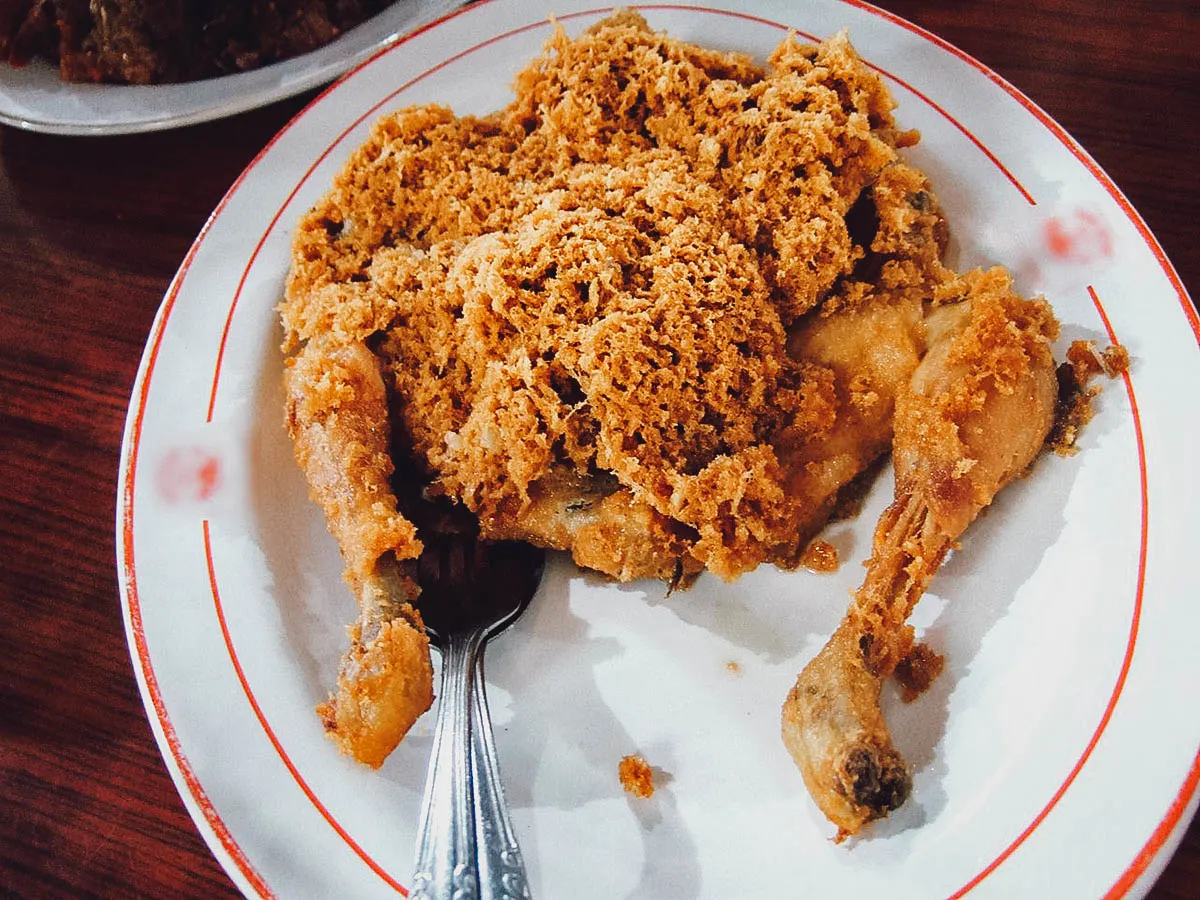One dish – sate.
This beloved Indonesian national dish of skewered and seasoned meat is perhaps the only dish people new to the cuisine need to eat to fall in love with Indonesian food. It’s so incredibly delicious.
In fact, so delicious is sate that it’s taken root in the cuisines of neighboring countries like Malaysia, Singapore, Thailand, and the Philippines. And thanks to their shared colonial history, it’s even become an integral part of Dutch cuisine.
But as delicious and popular as sate is, it’s hardly the only dish that’ll make you take an interest in Indonesian food. Nasi goreng, bakso, babi guling, and mie goreng are just a few other Indonesian dishes that’ll have you hankering for a cuisine that’s about as diverse and varied as the archipelago itself.
To be clear, there are literally thousands of traditional Indonesian recipes so this list of 30 is a mere snapshot of all that Indonesian food has to offer. It would take a lifetime to fully explore Indonesian cuisine so this list represents only the best dishes we’ve tried so far from our trips to Java and Bali.
INDONESIAN FOOD QUICK LINKS
If you’re planning a trip to Indonesia and want to really dive into the cuisine, then you may be interested in going on a food tour or taking a cooking class.
TOURS & OTHER SERVICES
- Food Tours: Food and Market Tours in Indonesia
- Cooking Classes: Cooking Classes in Indonesia
- eSIM: Indonesia eSIM
Save This on Pinterest!
No time to read this guide on the best food in Indonesia? Click on the save button and pin it for later!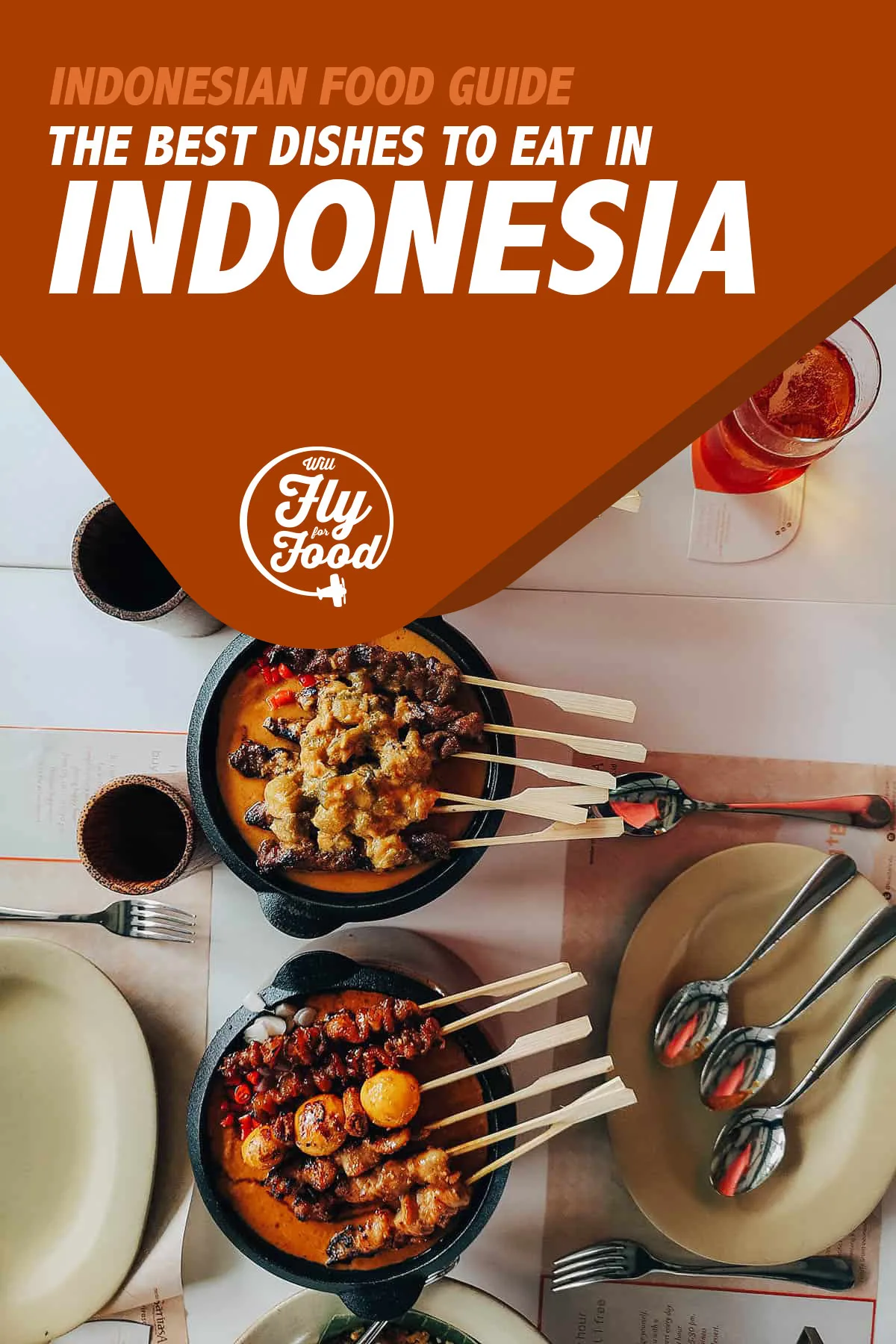
WHAT IS TRADITIONAL INDONESIAN CUISINE?
Indonesian cuisine represents the food, recipes, and culinary heritage of the world’s largest archipelago. Indonesia is comprised of 17,508 islands (around 6,000 of which are inhabited) and over 600 ethnic groups, many of which boast their own regional cuisines and culinary traditions.
In all, Indonesian cuisine has about 5,350 traditional recipes. They vary greatly from region to region and exhibit many foreign influences.
In Sumatra for example, you’ll find curried meat and vegetables dishes shaped by Indian and Middle Eastern influences. Eastern Indonesian cuisine is similar to Polynesian and Melanesian cuisines while Javanese food remains mostly indigenous with just hints of Chinese influence.
This confluence of culinary influences is a direct result of Indonesia’s long history as a conduit for trade in Southeast Asia. It’s cuisine was greatly influenced by the cuisines of India, China, the Middle East, Portugal, Spain, and the Netherlands.
Because of its vast regional diversity, it’s difficult to characterize Indonesian cuisine, though like many of its Southeast Asian neighbors, Indonesian food can best be described as rich and complex, and intensely flavorful.
WHAT IS A WARUNG?
You’ll probably come across this word often when exploring the food of Indonesia.
Traditionally speaking, a warung refers to a small family-run convenience store selling sundries, snacks, and other small grocery items. It’s typically attached to the front of a family’s home, much like a Filipino sari-sari store.
Today, the term has evolved to refer to modest Indonesian restaurants and cafes. Traveling through the country, you’ll find the term attached to many of these small Indonesian restaurants which are usually named after the main dishes they sell.
A warung roti bakar for example, sells grilled bread while a warung indomie sells mostly instant noodles.
If you intend to explore traditional Indonesian food, especially away from the bigger cities, then you’ll probably be spending a lot of time in these warungs.
THE BEST INDONESIAN DISHES
I’ve organized this Indonesian food guide by category to make it easier to digest. Click on a link to jump to any section.
NATIONAL DISHES
As described, Indonesian food varies greatly from region to region. National dishes are representative of a culture as a whole so if you’d like to experience Indonesian cuisine in broad strokes, then you should start with these six dishes.
1. Sate
As described, sate is one of the most popular and beloved dishes in Indonesian cuisine. It refers to a dish of seasoned, skewered, and grilled meat served with a sauce.
Sate is typically made with small pieces of chicken, beef, pork, mutton, fish, or seafood, but it can be made with many other types of meat and vegetables as well. They’re skewered on bamboo sticks and grilled over charcoal before being served with a variety of sauces, most often a combination of peanut sauce and kecap manis.
Sate is such a popular dish that it’s become a staple food in many other cuisines as well. It’s believed to have been developed by Javanese street food sellers who were trying to replicate Indian kebabs.
From Java, sate spread throughout the Malay archipelago, into countries like Malaysia where it’s become recognized as a national dish.
Sate is ubiquitous in almost every region of Indonesia and is equally popular at street food stalls as it is at warungs and more upscale Indonesian restaurants. It’s one of three Indonesian dishes that made it to CNN Travel’s reader’s poll on the World’s 50 Best Dishes.
RECIPE: Indonesian chicken sate
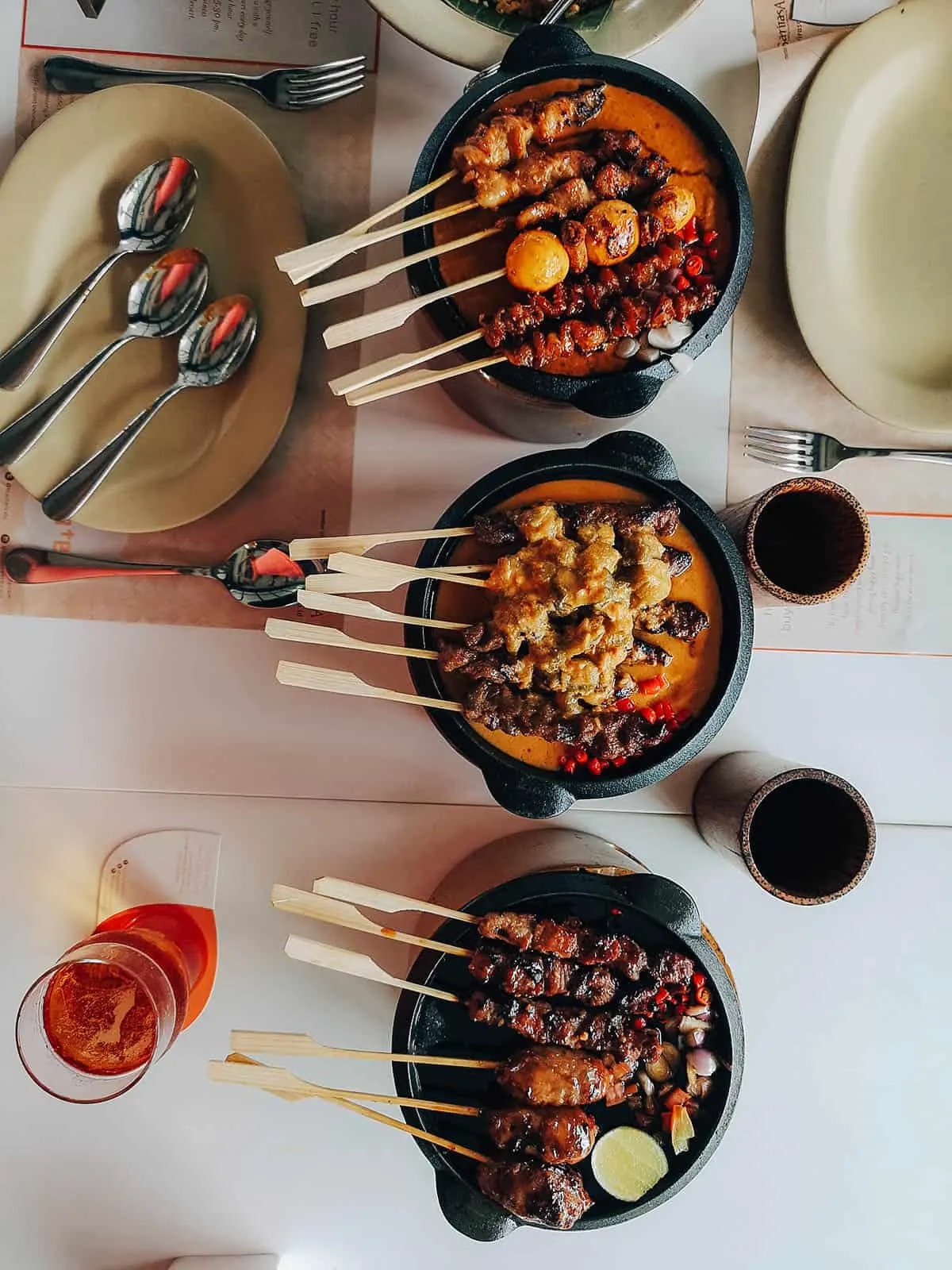
2. Nasi Goreng
Nasi goreng literally means “fried rice“. It’s an Indonesian fried rice dish made with kecap manis, shrimp paste, garlic, shallots, tamarind, and chili. I’ll talk about it more later in this guide but kecap manis is a thick sweetened soy sauce often used in Indonesian cuisine. It’s what gives nasi goreng its signature brown color.
Aside from the basic ingredients, nasi goreng can be made with a host of other ingredients like meat, seafood, egg, vegetables, and krupuk (traditional crackers). Pictured below is the delicious nasi goreng kambing (goat fried rice) we enjoyed at the legendary Kebon Sirih stall in Jakarta.
Like sate, nasi goreng made it to CNN Travel’s reader’s list of the World’s 50 Best Dishes.
RECIPE: Nasi goreng
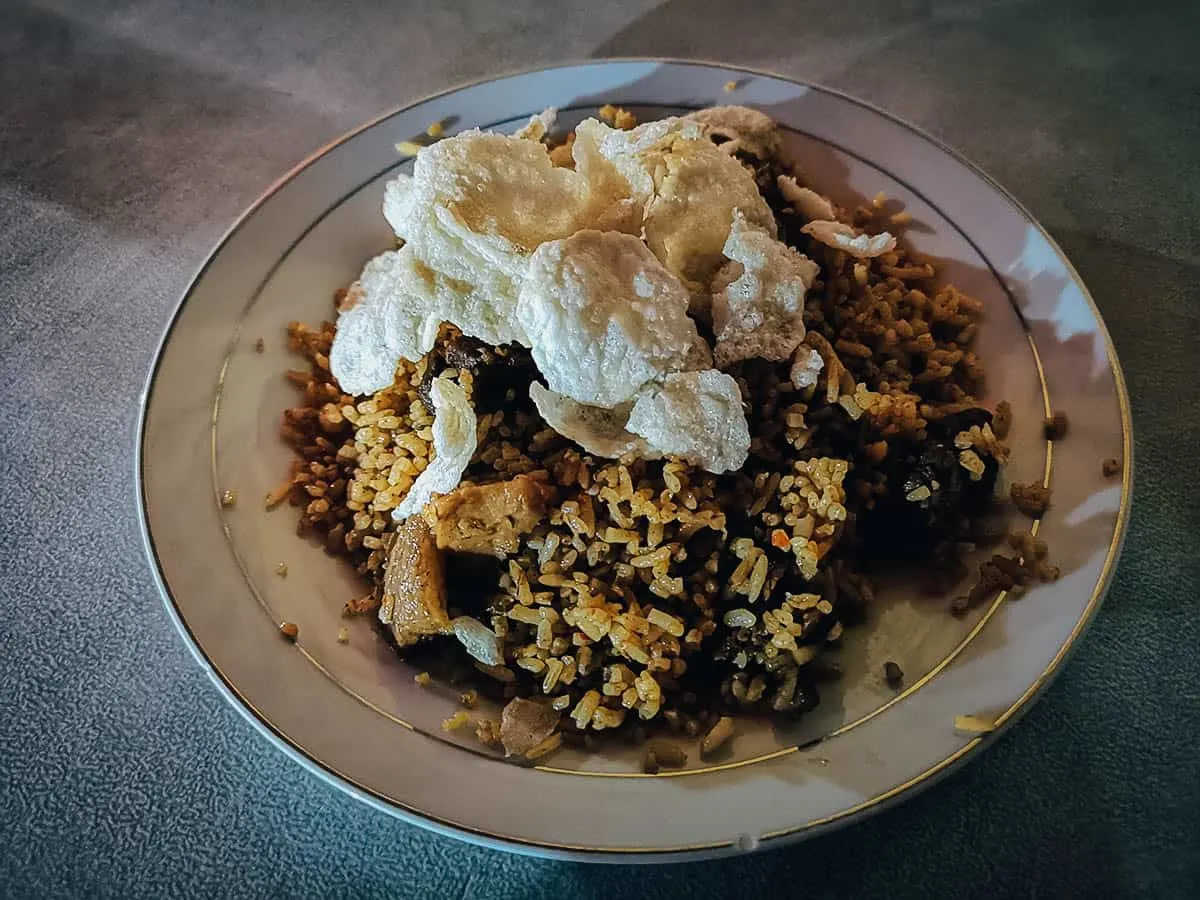
3. Tumpeng
Sate and nasi goreng may be more well-known to foreigners but tumpeng is the most important Indonesian dish on this list. In fact, until 2018, it was the only dish regarded as an Indonesian national dish by the Ministry of Tourism.
Tumpeng refers to a Javanese cone-shaped rice dish served with a multitude of sides on a banana-leaf covered tampah (woven bamboo tray). It can be made with plain steamed rice, uduk rice (with coconut milk), or yellow rice that’s fashioned into the shape of a perfect mountain using a cone-shaped woven bamboo container.
Tumpeng is an important dish in Indonesian culture because it’s regarded as a symbol of gratitude, a dish that’s often enjoyed to celebrate important events like festivals and birthdays. The cone-shaped rice is meant to symbolize the holy mountain while the many side dishes surrounding it carry meaning as well.
For example, spinach is regarded as a symbol of prosperity in Javanese culture. Catfish represents the importance of good preparation and humility while anchovies symbolize togetherness. It’s a highly symbolic dish and hailed as the one dish that binds the diversity of Indonesia’s various culinary traditions.
If you’re ever at an Indonesian gathering and someone serves you the top of the tumpeng, then consider it a huge honor. In Indonesian gratitude ceremonies called slametan, the top of the tumpeng is cut and typically given to the most important person in the group.
RECIPE: Mini nasi tumpeng
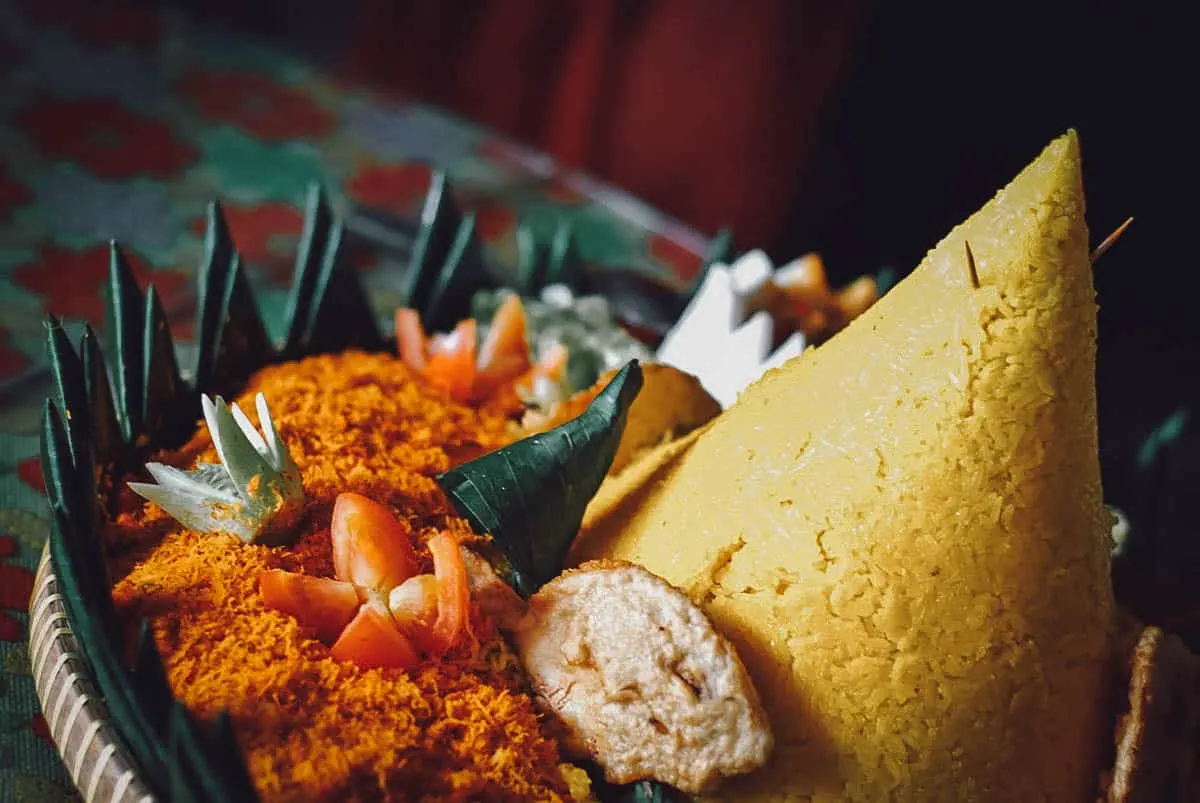
miss_yasmina, CC BY-SA 2.0, via Wikimedia Commons / Processed in Photoshop and Lightroom
4. Rendang
Rendang refers to an Indonesian meat dish that’s originally from the Minangkabau region in West Sumatra. It’s a curry-like dish that’s believed to have been influenced by north Indian curry.
Like tumpeng, rendang is an important Indonesian cultural food that’s often served at ceremonial gatherings like weddings and birthdays. It’s traditionally made with beef though it can be made with other animal proteins as well like chicken, duck, mutton, or water buffalo. The beef is slow-cooked for several hours in coconut milk and spices until it becomes tender.
Like many of the dishes on this list, rendang has become popular in other Southeast Asian countries as well like Malaysia, Singapore, and Brunei. It’s the only Indonesian dish that made it to CNN Travel’s list of the World’s 50 Best Foods.
RECIPE: Beef rendang
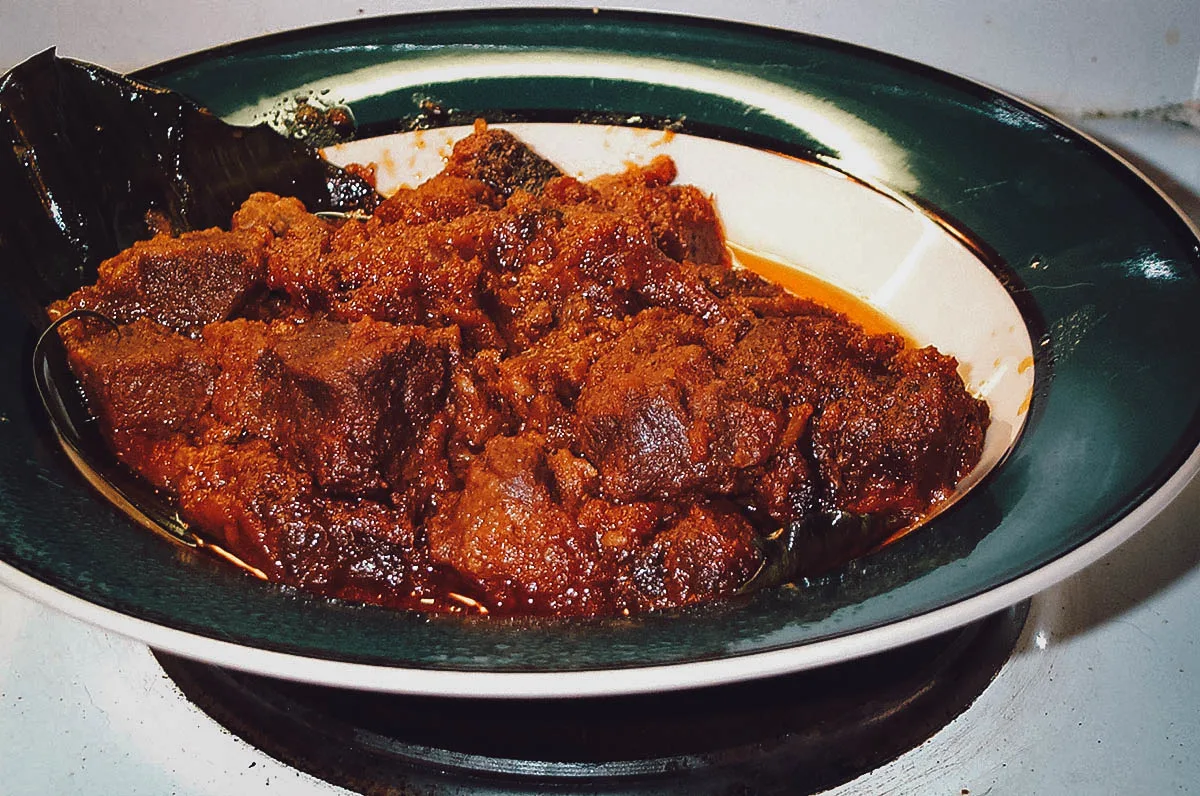
GeeJo, CC BY-SA 2.0, via Wikimedia Commons / Processed in Photoshop and Lightroom
5. Soto
Soto refers to a family of traditional Indonesian soups made with meat and vegetables. It’s most commonly made with chicken or beef though it can be made with other types of meat as well like mutton or buffalo.
Soto is widely consumed in many forms throughout Indonesia. It’s usually named after the region where it’s from or the main ingredient used to make it. Examples include soto bandung from Bandung (pictured below) and soto ayam which is chicken soup. Ayam means “chicken”.
Interestingly, there exists another family of soups in Indonesia called sop which are considered different from soto. Soto refers to traditional Indonesian soups while sop refers to soups that have foreign influences.
RECIPE: Soto ayam
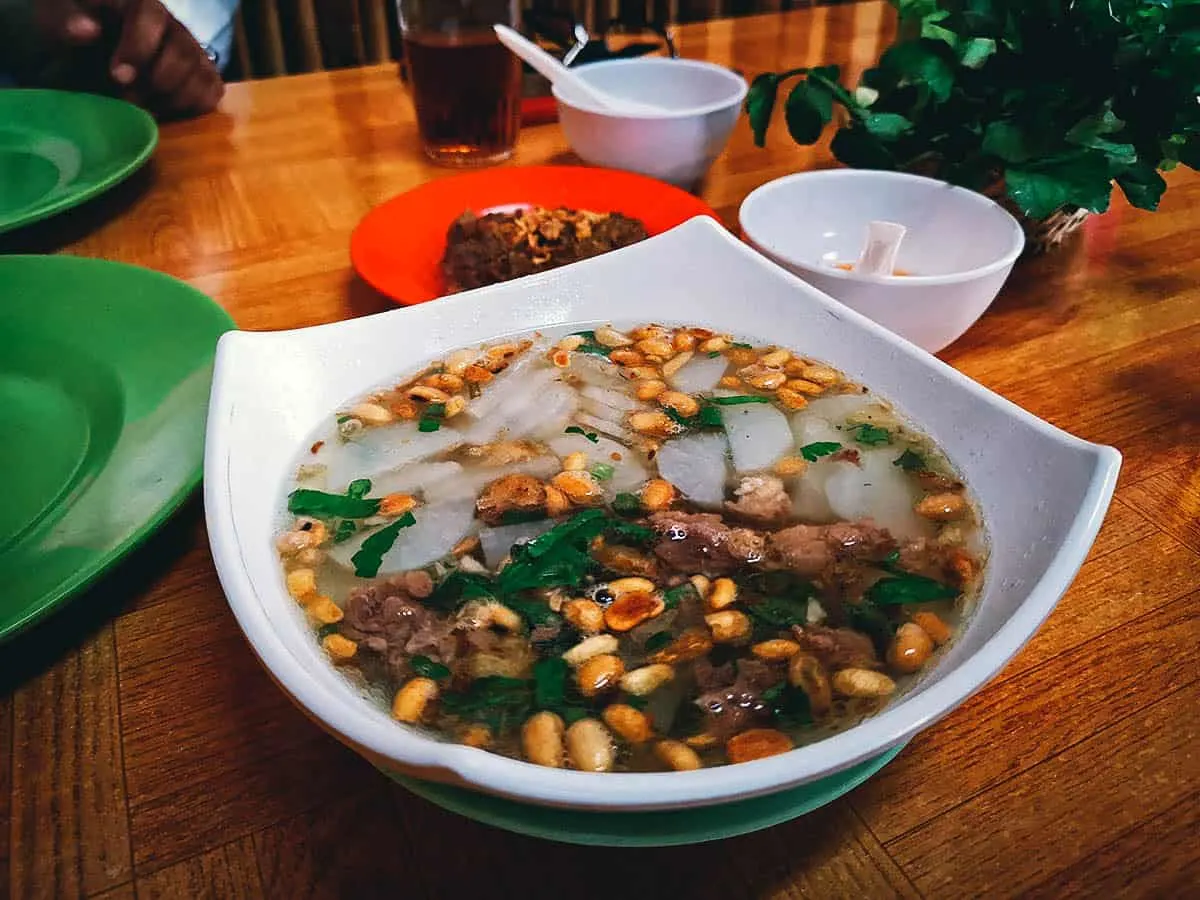
6. Gado-Gado
Gado-gado refers to an Indonesian salad made with slightly boiled, blanched, or steamed vegetables served with a peanut sauce dressing. It’s name literally means “mix-mix” and is in reference to the host of ingredients used to make it like hard-boiled eggs, potatoes, bean sprouts, tofu, tempeh, and krupuk.
Like soto, there exist several variations of gado-gado which are usually named after the region where they’re from. Examples include gado-gado padang, gado-gado betawi, and gado-gado sidoarjo.
Pictured below is a dish called lotek, which if I understand correctly, is a type of Javanese or Sundanese gado-gado.
RECIPE: Gado-gado
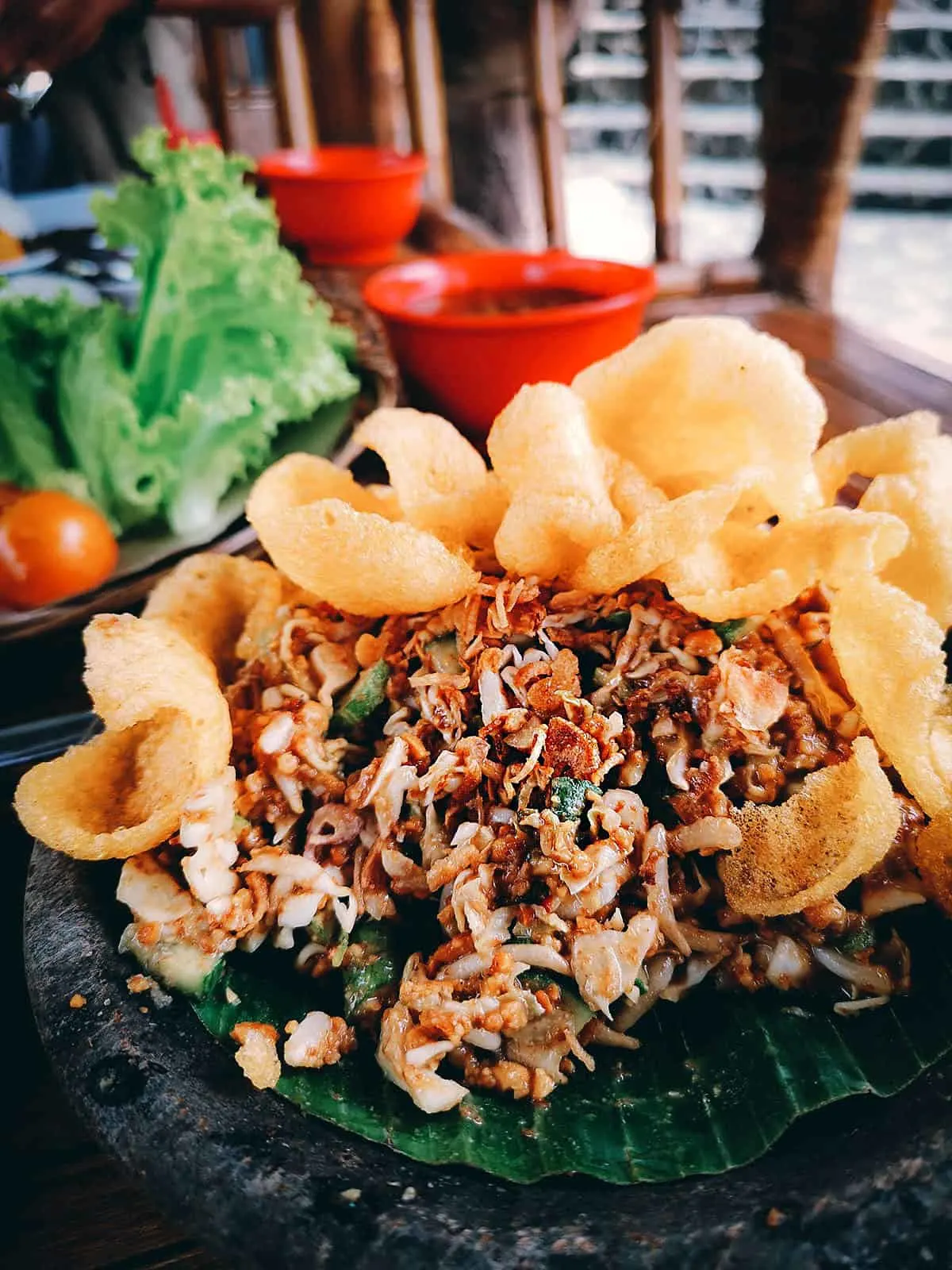
SOUPS / SALADS / STARTERS
7. Sop
As described, soto refers to traditional Indonesian soups while sop describes soups that have foreign influences. I can’t find any other information to differentiate the two but that appears to be the only distinction.
One of the most popular types of sop is sop buntut. It’s a delicious and hearty oxtail soup in a clear beef broth made with a host of ingredients like carrots, potatoes, tomatoes, celery, leeks, and fried shallots.
RECIPE: Sop buntut
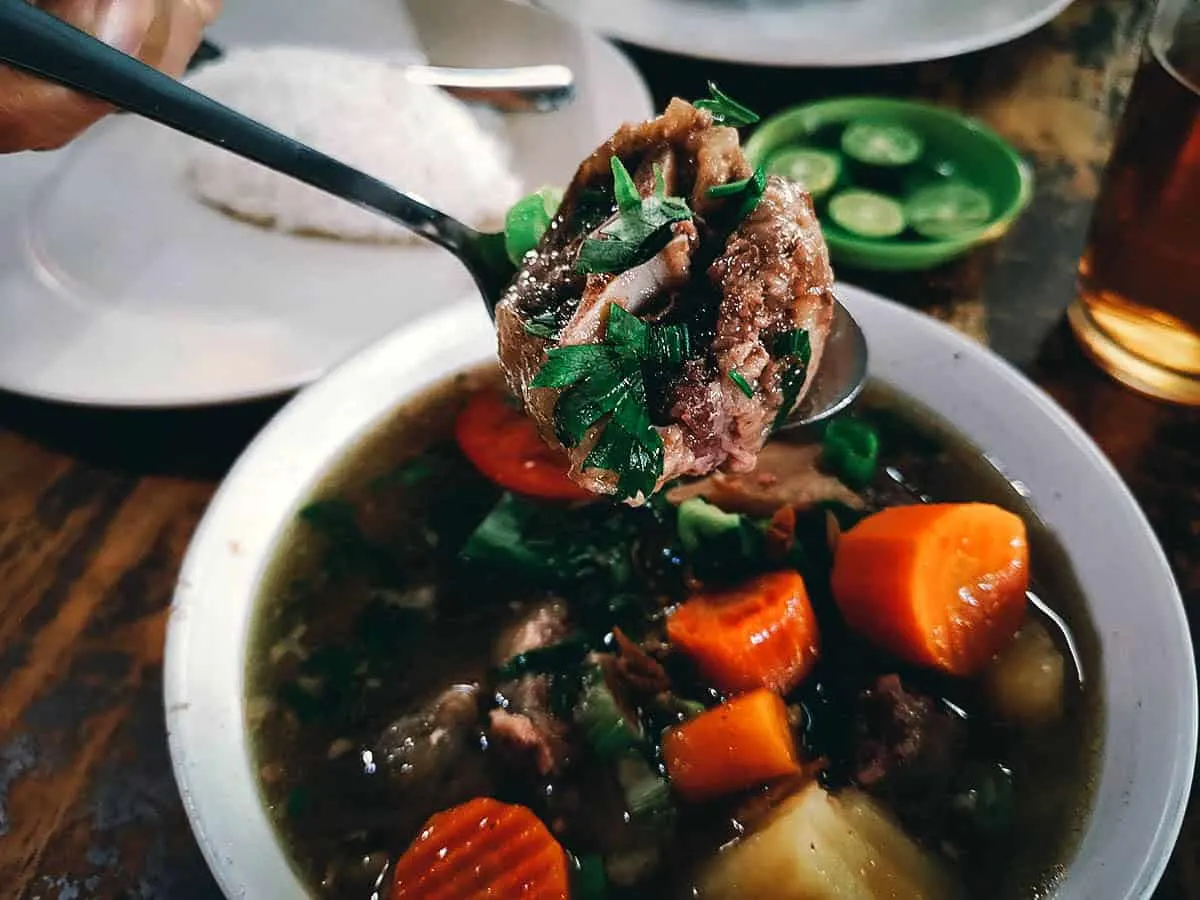
8. Rujak
Rujak is a traditional Javanese fruit and vegetable salad dish. It exists in many forms throughout Indonesia and is one of the earliest historically identified foods of ancient Java.
Rujak is typically made with sliced fresh fruits and vegetables served with a spicy sugar palm dressing. Unlike western fruit salads, rujak tastes tangy, sweet, and spicy thanks to the dressing made from ground chilli, palm sugar, shrimp paste, and peanuts.
Commonly sold at warungs and markets and from pushcarts, rujak is widely available throughout Indonesia and has become popular in other Southeast Asian countries as well like Singapore and Malaysia.
RECIPE: Rujak buah
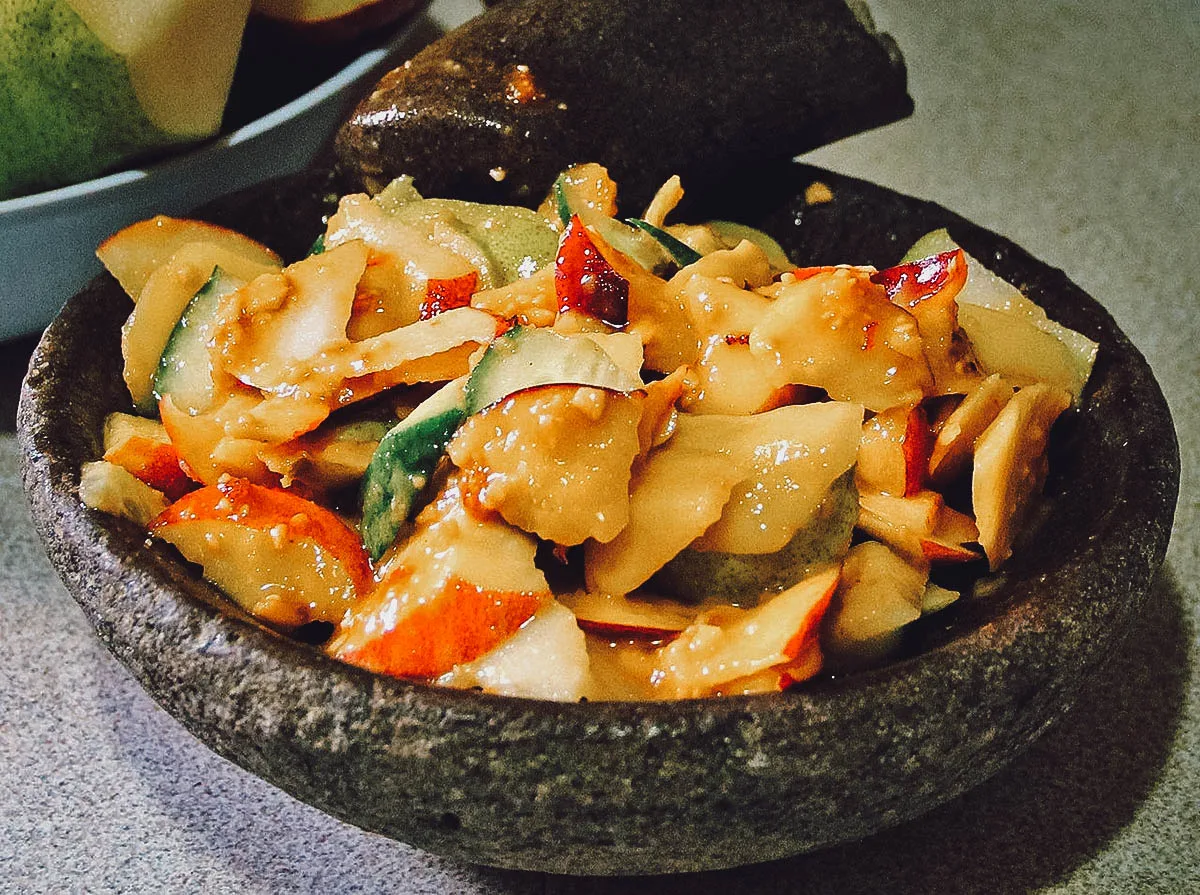
Sofiah Budiastuti, CC BY-SA 4.0, via Wikimedia Commons / Processed in Photoshop and Lightroom
9. Bakso
Bakso refers to an Indonesian meatball made from beef surimi. It’s springier than your typical meatball and is closer in texture to a Chinese fish ball.
Unlike regular meatballs made with ground meat, bakso is usually made with much more finely ground beef mixed with a small amount of tapioca flour and salt. Beef is the most common though it can be made with other proteins as well like chicken or fish, even pork.
Bakso has a dense and much more even texture throughout. It can be served in noodle soup dishes or on its own as a soup. You’ll find bakso sold everywhere in Indonesia, from street food carts to warungs to more upscale restaurants.
RECIPE: Bakso
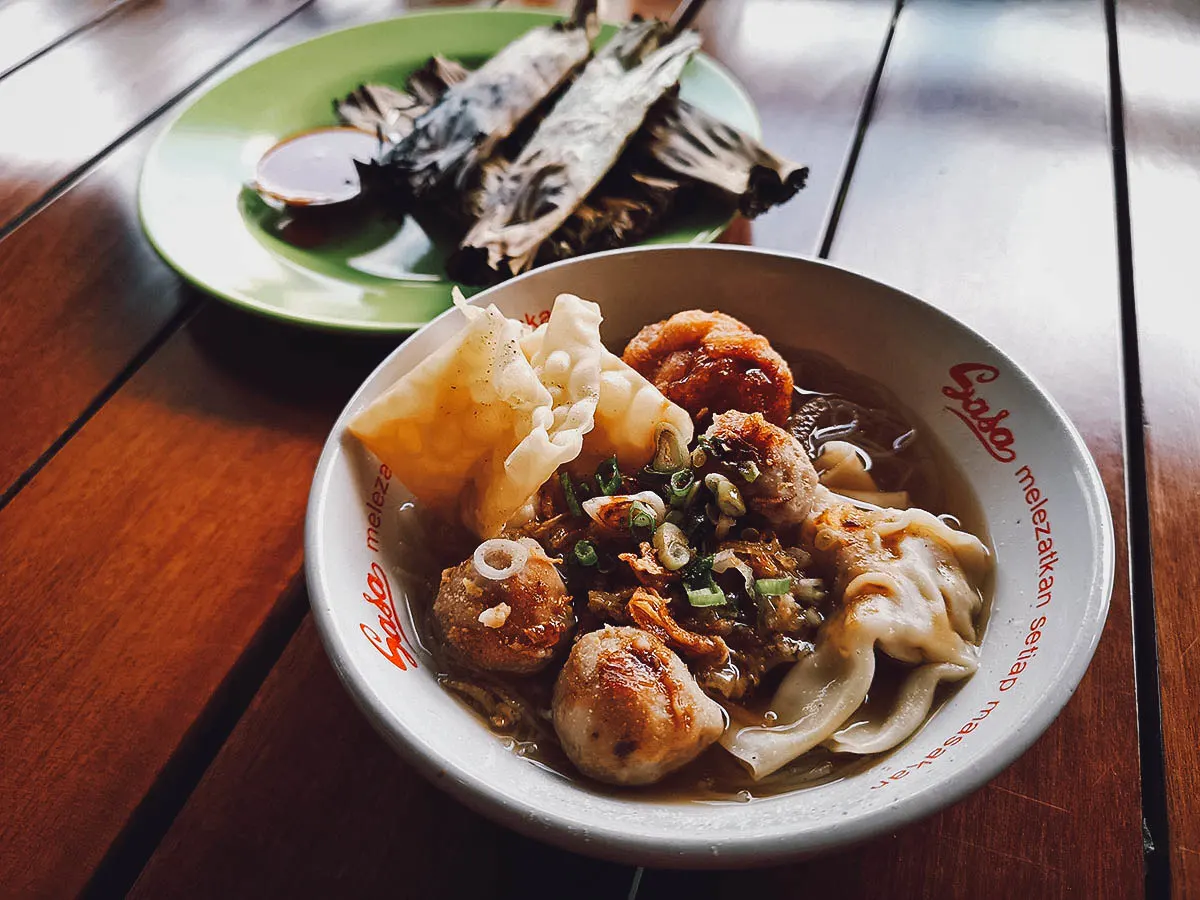
10. Siomay / Batagor
Siomay and batagor are Indonesian fish dumplings served with a peanut sauce. They’re both derivatives of Chinese shumai with the main difference being that siomay is steamed while batagor is fried.
To prepare, fish paste is stuffed into wonton skins and then either steamed or deep-fried. They’re typically made from tenggiri or Spanish mackerel though they can be made from other seafood proteins as well like tuna or prawn. As you’d expect, batagor tastes like a crispy version of siomay.
Originally from Bandung, siomay and batagor have become widely available throughout Indonesia and are often enjoyed as a snack. They’re typically served with peanut sauce along with condiments like kecap manis, sambal, and lime juice.
RECIPE: Siomay Bandung
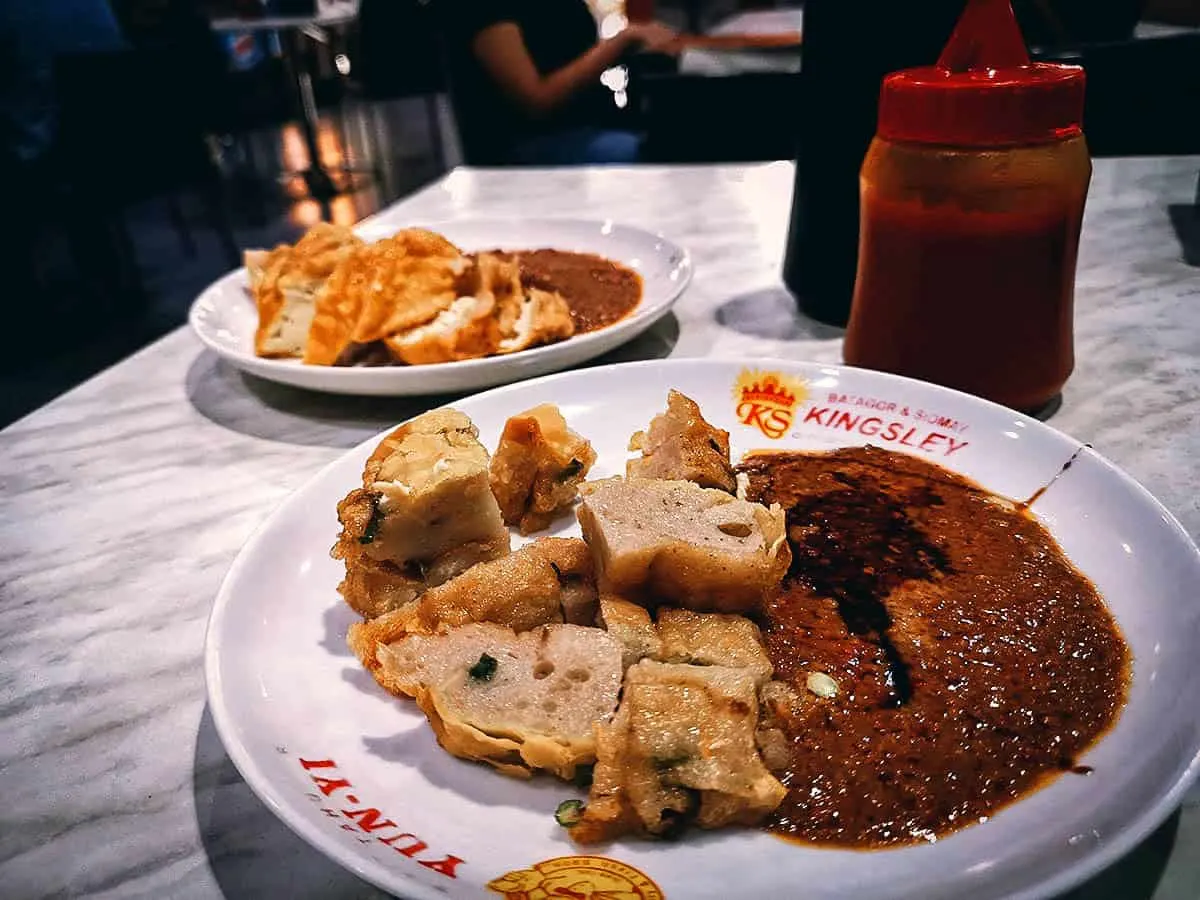
11. Pempek
Pempek is a type of fishcake originally from Palembang in South Sumatra. Like batagor, it’s a Chinese-influenced dish commonly made with deep-fried tenggiri fish meat.
Pempek is made with boneless ground fish meat mixed with water, salt, and sago flour. The dough is boiled or steamed before being deep-fried and served with a sweet and sour sauce made from palm sugar, chili, garlic, vinegar, and salt.
Pempek is typically cut into bite-sized portions and often served with yellow noodles or rice vermicelli, sliced cucumber, and krupuk. Pempek fish dough is always used though many variants exist based on shape and additional ingredients used.
RECIPE: Indonesian fried fish cakes with tamarind sauce
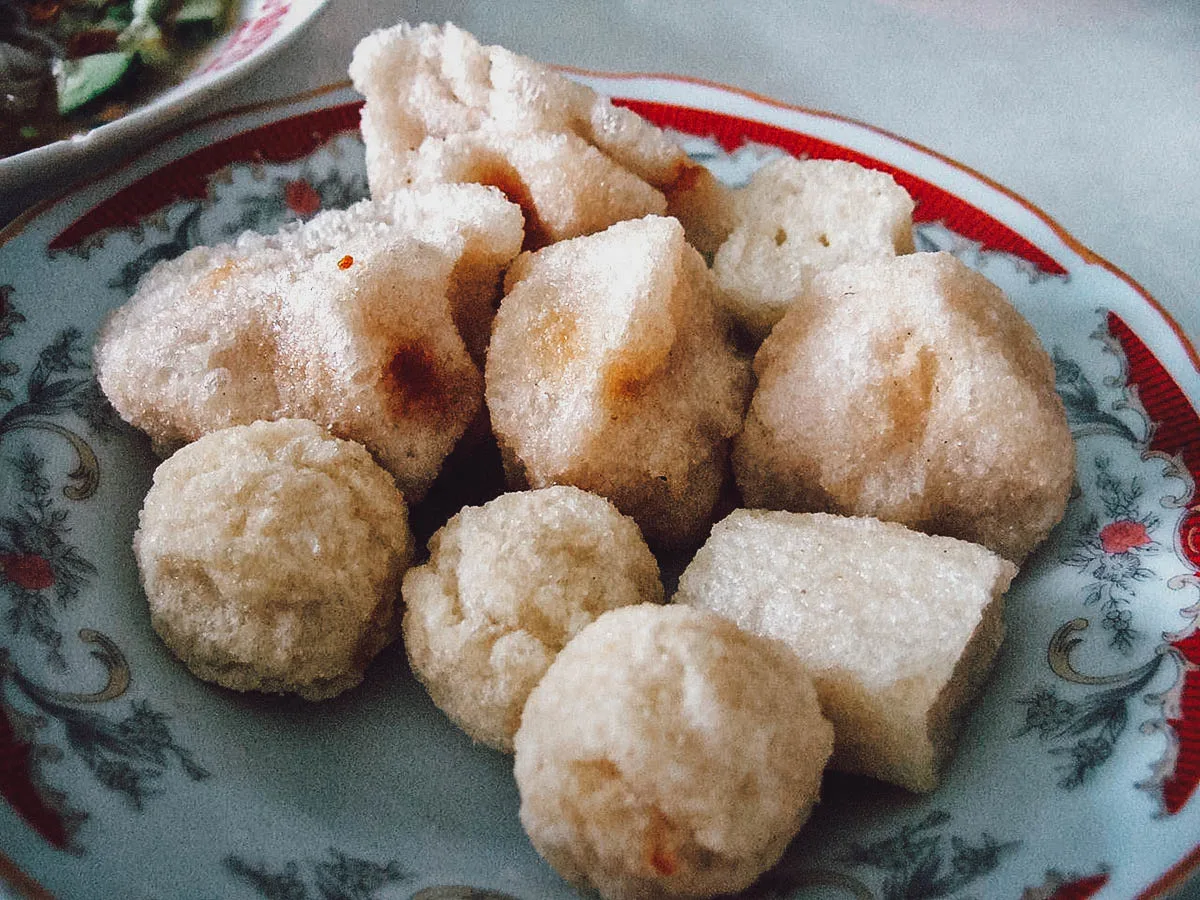
Midori, CC BY-SA 3.0, via Wikimedia Commons / Processed in Photoshop and Lightroom
12. Sate Padang
Sate padang is an interesting type of sate from Padang in West Sumatra. It’s so unique that I felt it deserved its own spot in this food guide.
Sate padang is a type of beef satay served with a thick yellow-brown sauce. What makes sate padang special is the sauce. It’s made from rice flour mixed with beef and offal broth and a host of spices and other ingredients like turmeric, ginger, garlic, coriander, galangal, cumin, and curry powder.
Sate padang is typically made with beef though it can be made with other proteins as well like chicken, goat, lamb, and mutton. It’s often served on a banana leaf with ketupat (rice cake) and sprinkled with crispy fried shallots.
RECIPE: Sate Padang
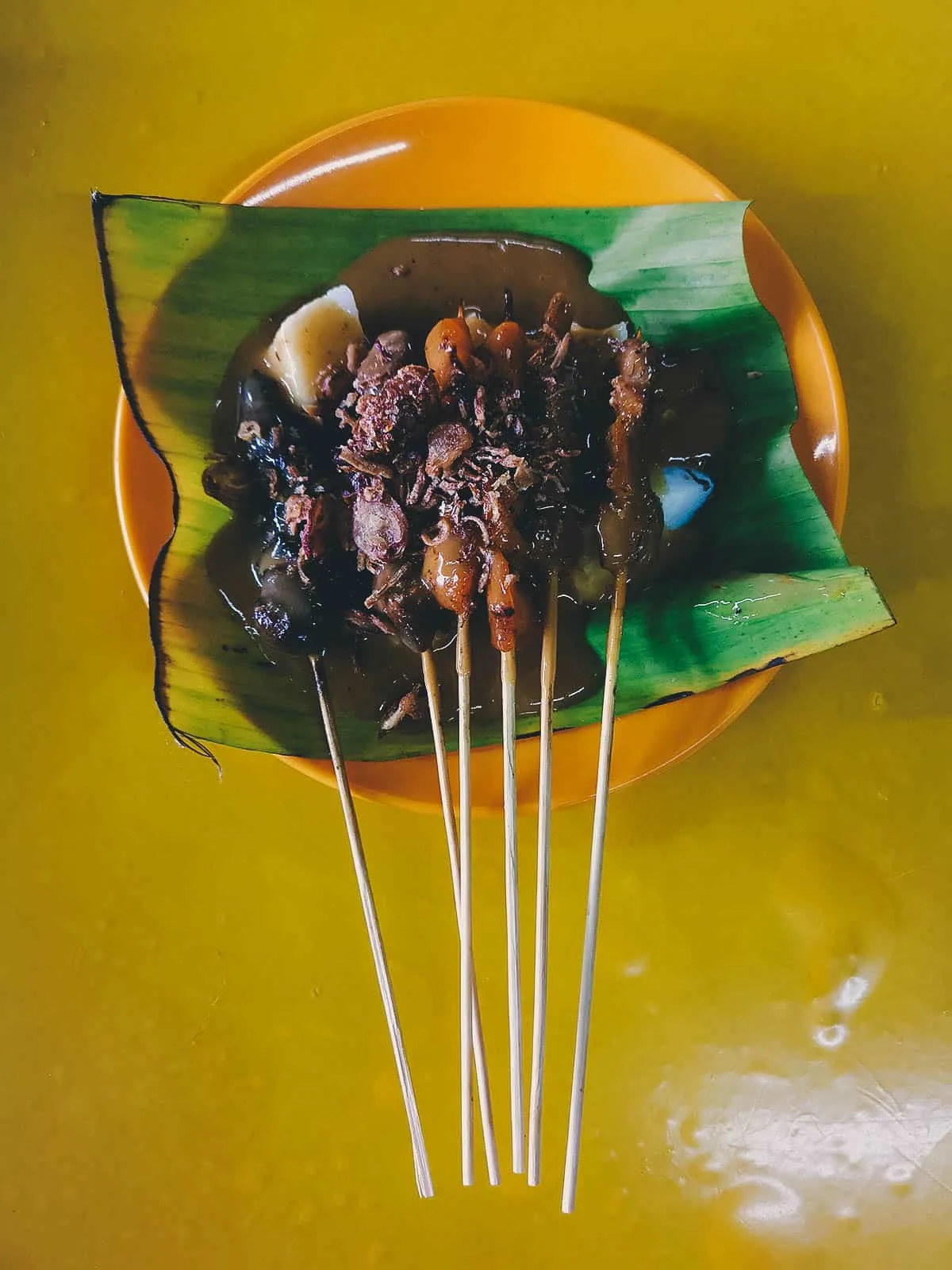
MEAT / POULTRY / SEAFOOD
13. Iga Babi Bali
Iga babi bali refers to Balinese barbecued pork ribs covered in a sticky kecap manis glaze. Like babi guling, it’s delicious and one of the most popular pork dishes you can have in Bali.
Unlike the rest of Indonesia, Bali is predominantly Hindu which is why pork is a common ingredient on the island. Aside from it’s natural beauty, I think this is one of the reasons why Bali is such a popular tourist destination – fewer restrictions on food and drink.
We had this delicious slab of iga babi at Naughty Nuri’s in Seminyak, one of the most famous restaurants in Bali. They became famous internationally after being featured on the Bali episode of No Reservations with Anthony Bourdain.
RECIPE: Iga babi bali
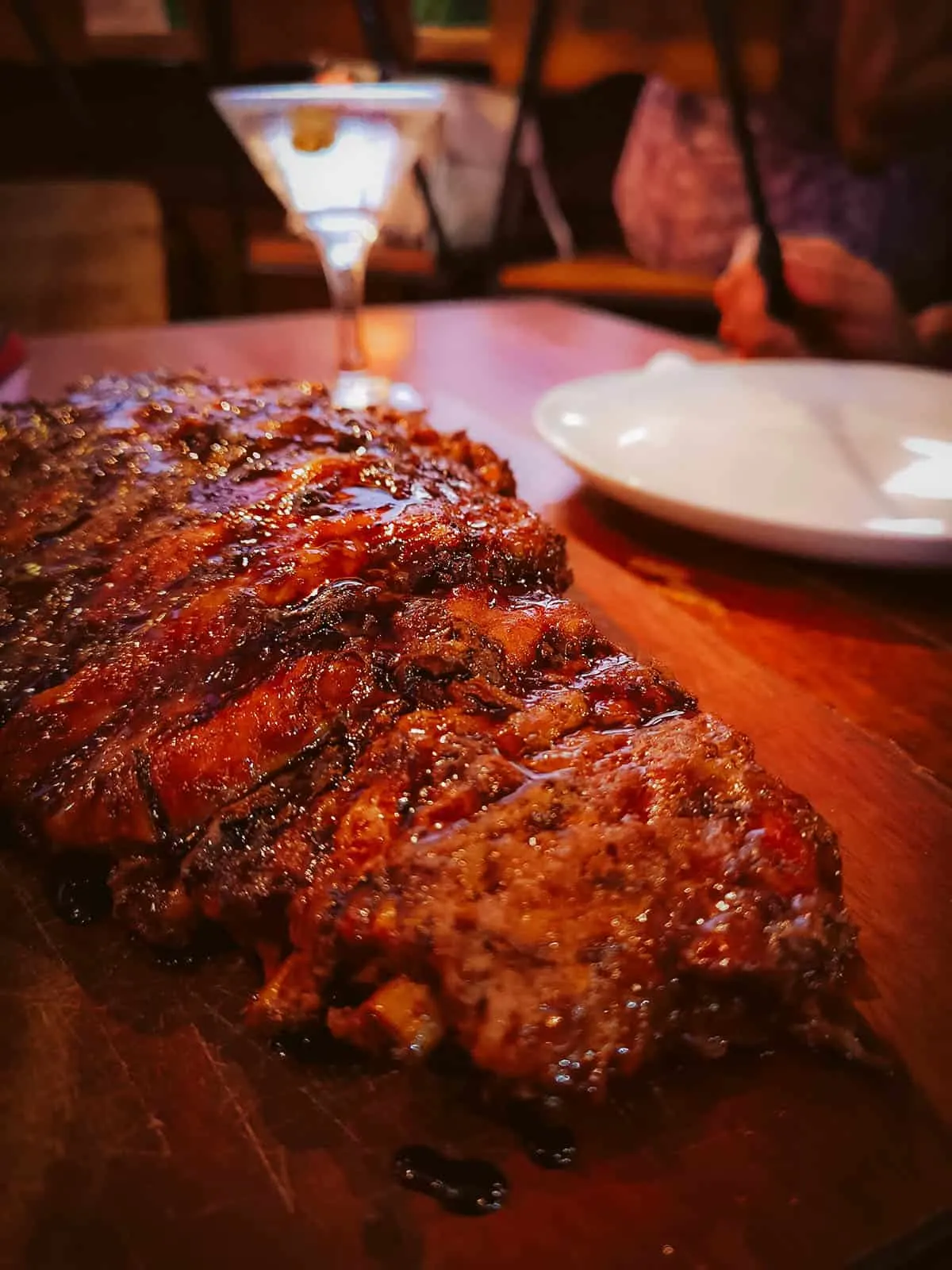
14. Bebek (Goreng / Bakar)
Bebek is the Indonesian word for “duck”. Like any animal protein, it can be prepared in any number of ways, though two of the most popular recipes in Indonesian cuisine are bebek goreng and bebek bakar which are fried duck and grilled duck respectively.
Bebek goreng is made with ducks that are boiled or steamed before being coated in spices and deep-fried till crispy. It’s usually served with steamed rice, vegetables, lime, and sambal.
Pictured below is the plate of bebek goreng I had in Bali. It’s crispy and delicious and one of my favorite dishes to eat in Indonesia.
RECIPE: Bebek goreng
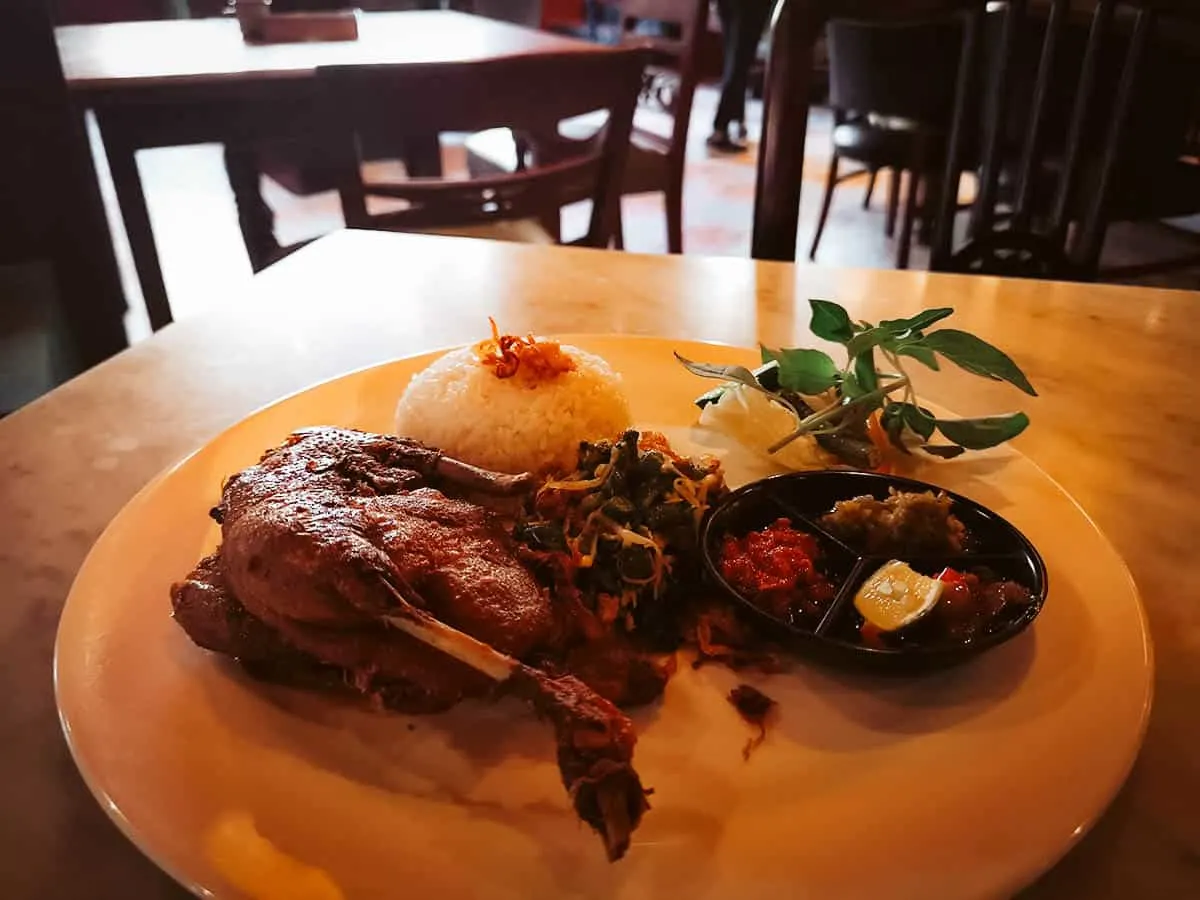
Pictured below is bebek bakar or grilled duck. The process is similar to bebek goreng except the duck is brushed with honey, sugar, and margarine before being grilled over charcoal. It’s sweet and smokey and every bit as enjoyable as bebek goreng.
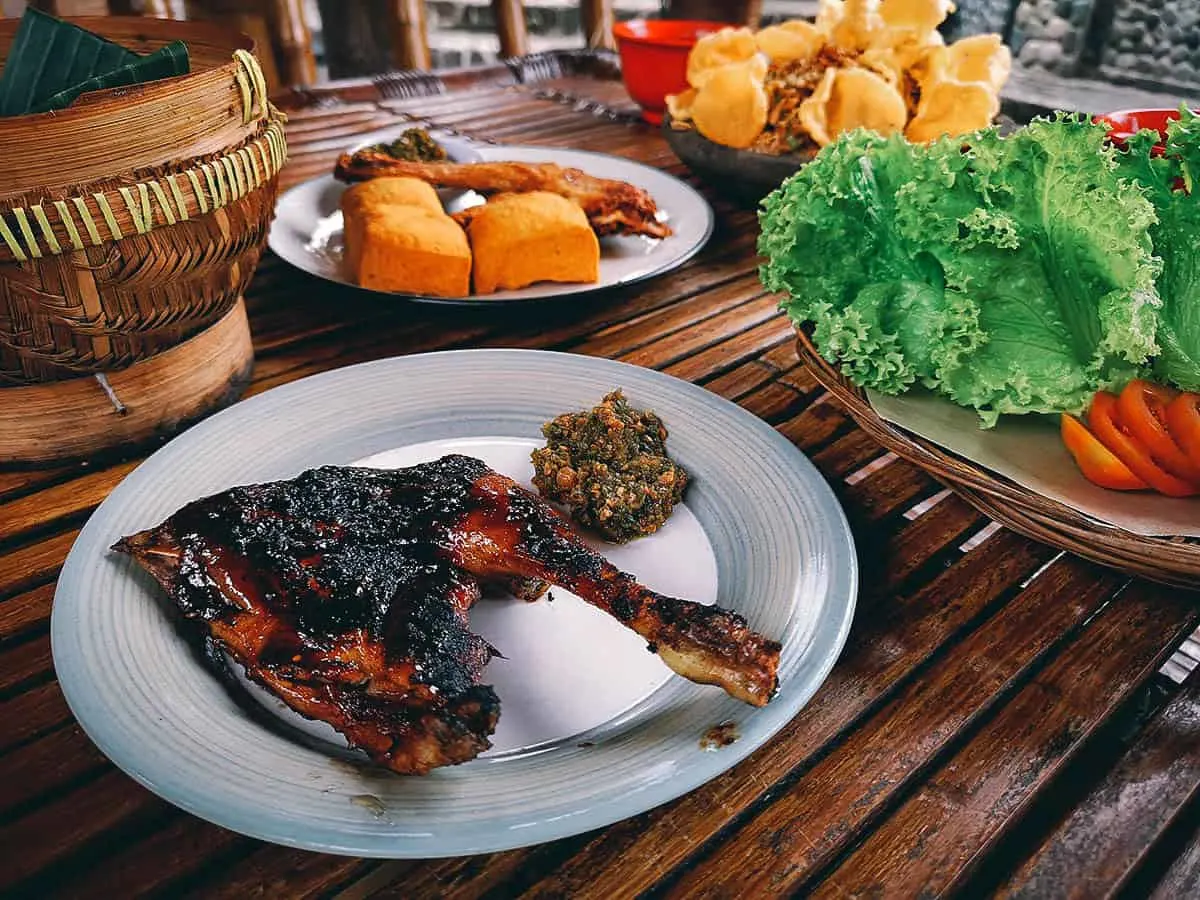
15. Bebek Betutu
Bebek betutu is perhaps one of the most interesting dishes you can have in Bali. It refers to an intensely seasoned Balinese dish of steamed or roasted duck cooked in a betutu spice mixture.
Bebek betutu gets its name from a Balinese spice mixture made with a host of spices and ingredients like garlic, ginger, galangal, turmeric, candle nuts, chili, and shrimp paste. They’re ground into a fine paste using a mortar and pestle and sauteed with coconut oil before being stuffed into the duck and cooked.
Bebek betutu is a ceremonial Balinese dish. It’s time-consuming to prepare so you’ll typically need to order it at least a day in advance. Unlike bebek goreng or bebek bakar which are firmer in texture, the meat in bebek betutu practically slides off the bone.
Because it’s made with so many spices, bebek betutu is incredibly fragrant and aromatic, to the point of being almost perfume-y. It’s an interesting dish and a must-try in Bali.
RECIPE: Bebek betutu
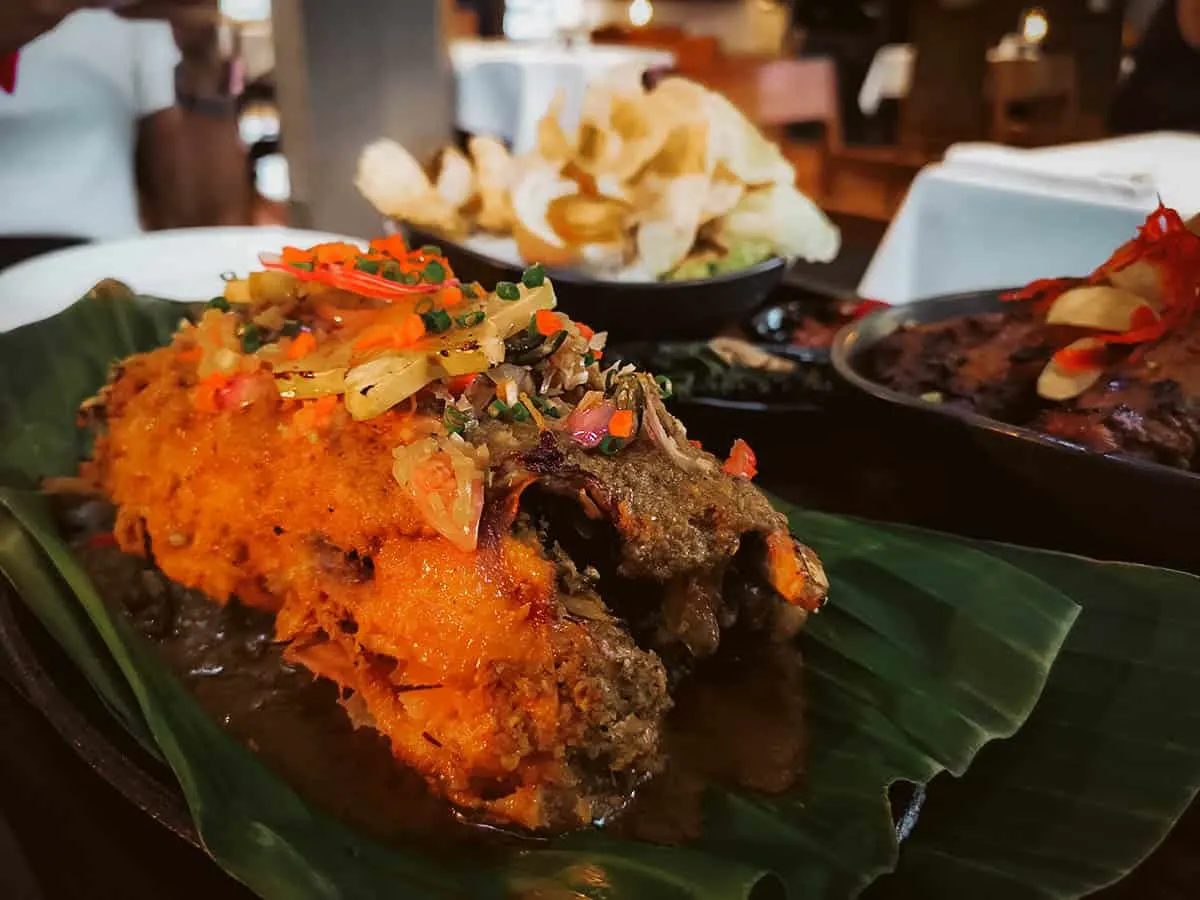
16. Ayam (Goreng / Bakar)
Ayam means “chicken” so ayam goreng and ayam bakar refer to fried and grilled chicken respectively.
Unlike American-style fried chicken, ayam goreng isn’t coated in batter or flour. Instead, it’s rubbed in a spice mixture made from a multitude of ingredients like garlic, shallots, turmeric, lemongrass, bay leaves, and galangal before being deep-fried.
True to the diversity of Indonesian food, even fried chicken has many recipes and varieties. Pictured below is ayam goreng kremes, a type of Indonesian fried chicken topped with crispy bits of deep-fried flour.
RECIPE: Ayam goreng
Ayam bakar or Indonesian grilled chicken can vary from region to region but the spice mixture used to make it typically consists of the same set of ingredients like garlic, chili, shallots, coriander, turmeric, galangal, and tamarind juice.
The chicken pieces are often partially cooked in the spice mixture before being charcoal-grilled to imbue them with as much flavor as possible. The rest of the spice mixture is then applied to the chicken as it grills.
In Java, ayam bakar tends to be sweeter because the chicken is basted with kecap manis and coconut oil while grilling.
17. Ikan (Goreng / Bakar)
Ikan means “fish” so ikan goreng and ikan bakar refer to Indonesian fried fish and grilled fish respectively.
Recipes vary but ikan goreng is typically made by marinating fish like carp, gourami, or milkfish in a spice paste similar to the mixture used for ayam goreng. It’s then deep-fried in extremely hot coconut oil until it turns golden brown and the bones become crispy and edible.
Ikan bakar is marinated in a similar spice mixture before being quickly grilled over a hot charcoal fire. Methods vary from region to region but most ikan bakar tend to be on the sweet side thanks to the generous amount of kecap manis used either as a glaze or as a dipping sauce.
Both ikan goreng and ikan bakar are usually eaten with steamed white rice and sambal.
RECIPE: Ikan bakar
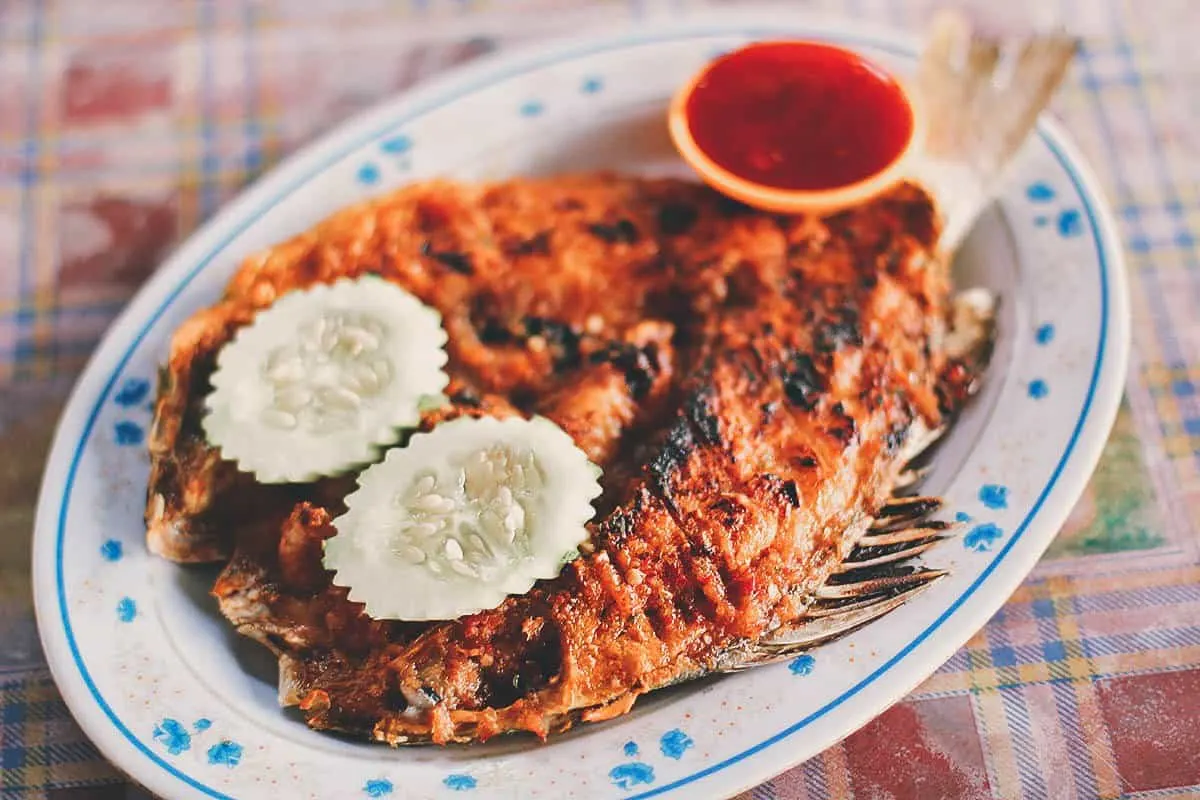
18. Tempeh
Tempeh isn’t meat, poultry, or seafood but it’s often used as a meat substitute so I’ve added it here. It refers to a Javanese food product made from fermented soybeans bound into cake form. Like tofu, it’s made from soybeans but the production process is different.
Tofu is made from curdled soy milk that’s been pressed into solid white blocks. Tempeh, on the other hand, is made from whole soybeans that are cooked, fermented, and molded into a block.
Fermented soybean is the main ingredient in tempeh but it’s made with other ingredients as well like brown rice, quinoa, flax seed, and spices. It’s firmer in texture and tastes earthier and nuttier than tofu which is more neutral in flavor. It also contains more protein, fiber, and nutrients and is generally considered to be the superior superfood between the two.
Tempeh is commonly deep-fried or stir-fried and used in many Indonesian dishes like soups, salads, sandwiches, and stews.
RECIPE: Tempeh kecap
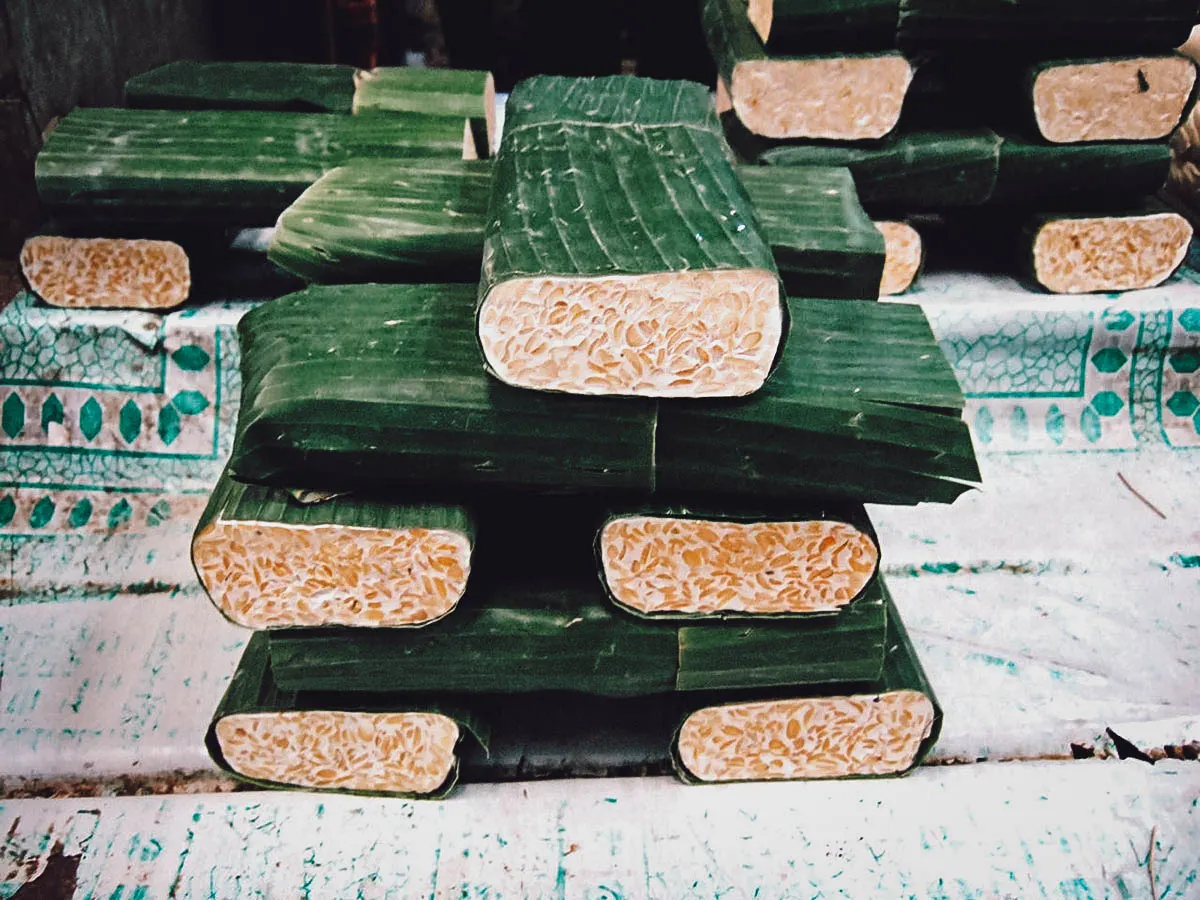
Sakurai Midori, CC BY-SA 2.1 JP, via Wikimedia Commons / Processed in Photoshop and Lightroom
RICE / NOODLES
19. Nasi Campur
Nasi campur refers to a type of rice meal enjoyed throughout Indonesia. You may find them called by different names depending on the region but they’re basically meals served with steamed white rice and a variety of different meat, seafood, and vegetable side dishes.
To be honest, I have trouble understanding the exact distinction between these types of rice meals. They exist in other Southeast Asian countries as well where they have different names like nasi kandar and nasi ambeng. To the untrained eye, they all look the same. Nasi means “rice”.
If I understand correctly, nasi campur is the general term used to describe these types of rice meals in Indonesia. There exist regional sub-varieties that can have specific components and go by a different name – like nasi padang from West Sumatra, nasi rames from Java, and nasi ingkung from Yogyakarta – but they can all be considered nasi campur.
Pictured below is a type of nasi campur from Bali called nasi bali. Typical side dishes include beef cubes, grilled tuna, tempe, tofu, cucumber, spinach, vegetable curry, corn, and sambal.
RECIPE: Nasi campur
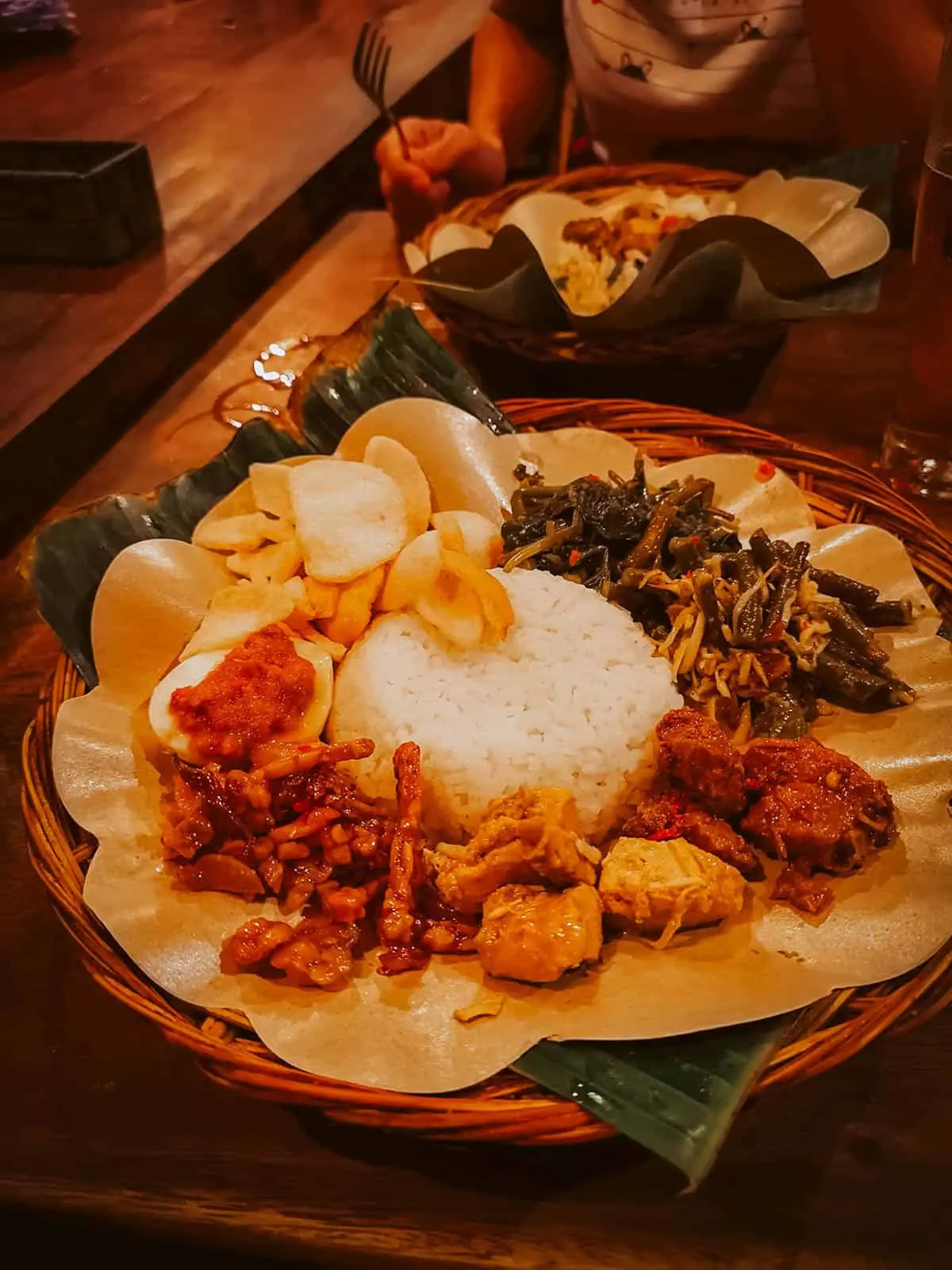
20. Nasi Padang
As described, nasi padang refers to a specific type of nasi campur from Padang in West Sumatra. It’s considered one of the most important Indonesian dishes to come from the island of Sumatra so I’ve listed it on its own in this guide.
Nasi padang consists of steamed white rice served with any variation of about 40 different types of meat, poultry, seafood, vegetable, and sambal dishes. Popular side dishes include boiled cassava leaves, unripe jackfruit curry, beef curries, duck curry, grilled chicken, fried seafood, and fried stink beans.
Nasi padang meals are served in one of two ways – pesan and hidang. Smaller restaurants typically employ the pesan method, meaning customers point at the side dishes they want and the server brings them to you stacked on a plate with rice (similar to Filipino turo-turo).
Larger restaurants will usually employ the hidang method where they bring rice and at least a dozen dishes to your table. You’re free to choose whatever dishes you want and only pay for what you eat.
RECIPE: Nasi Padang
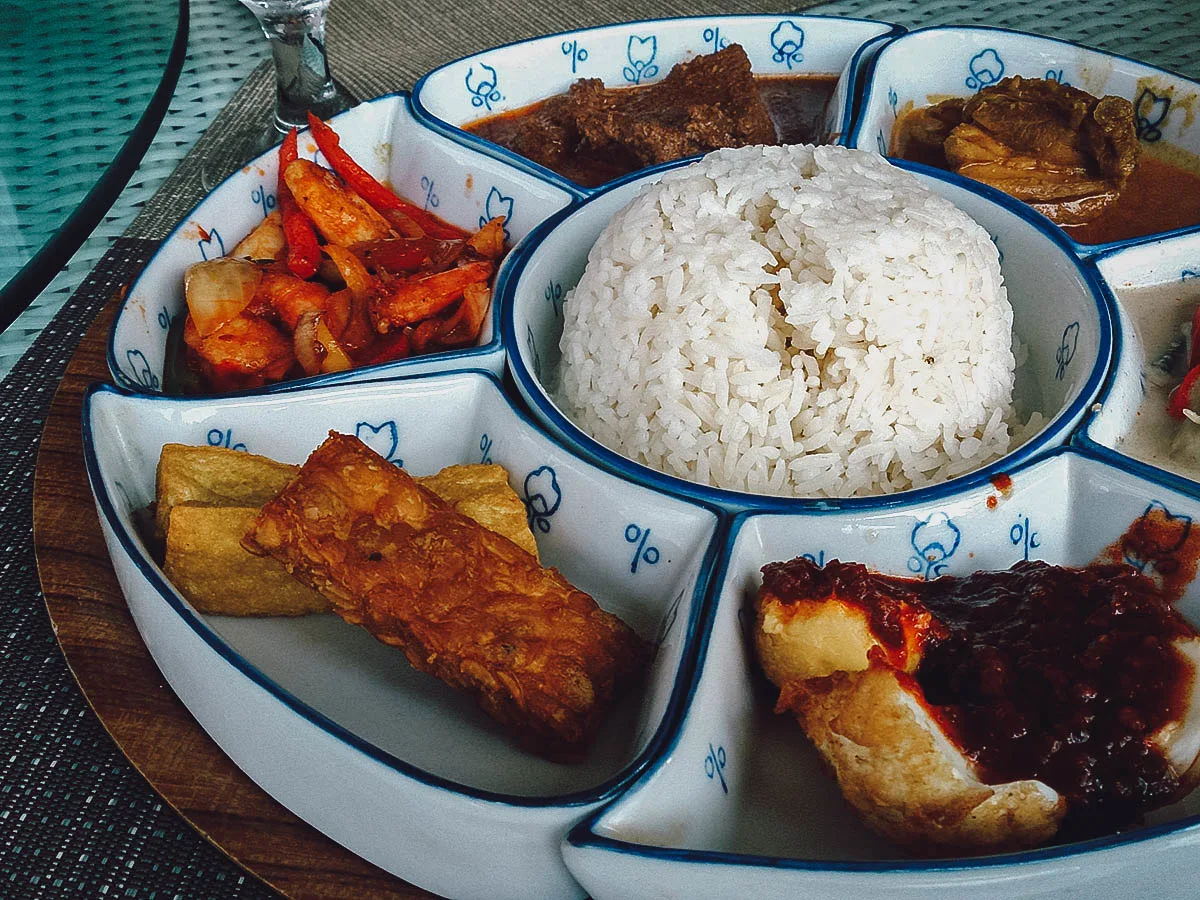
ProjectManhattan, CC BY-SA 3.0, via Wikimedia Commons / Processed in Photoshop and Lightroom
21. Nasi Brongkos
I don’t think nasi brongkos can be considered a type of nasi campur since it seems to be a more specific type of rice meal. It’s a specialty of Yogyakarta and resembles a stew with rice more than your typical Indonesian rice meal.
Nasi brongkos refers to a meal of steamed white rice served with a coconut-milk-based stew made with diced meat (usually beef, goat, or mutton), hard-boiled egg, tofu, beans, and chayote. What makes it special is the stew which is made with a variety of spices.
Brongkos stew is typically made with ingredients like black kluwek, lemongrass, kaffir lime leaves, bay leaves, palm sugar, and a spice paste mixture consisting of galangal, ginger, coriander, shallots, roasted candlenut, and whole bird’s eye chilis.
Like gudeg, nasi brongkos is considered a true Javanese dish that’s largely associated with the city of Yogyakarta.
RECIPE: Nasi brongkos
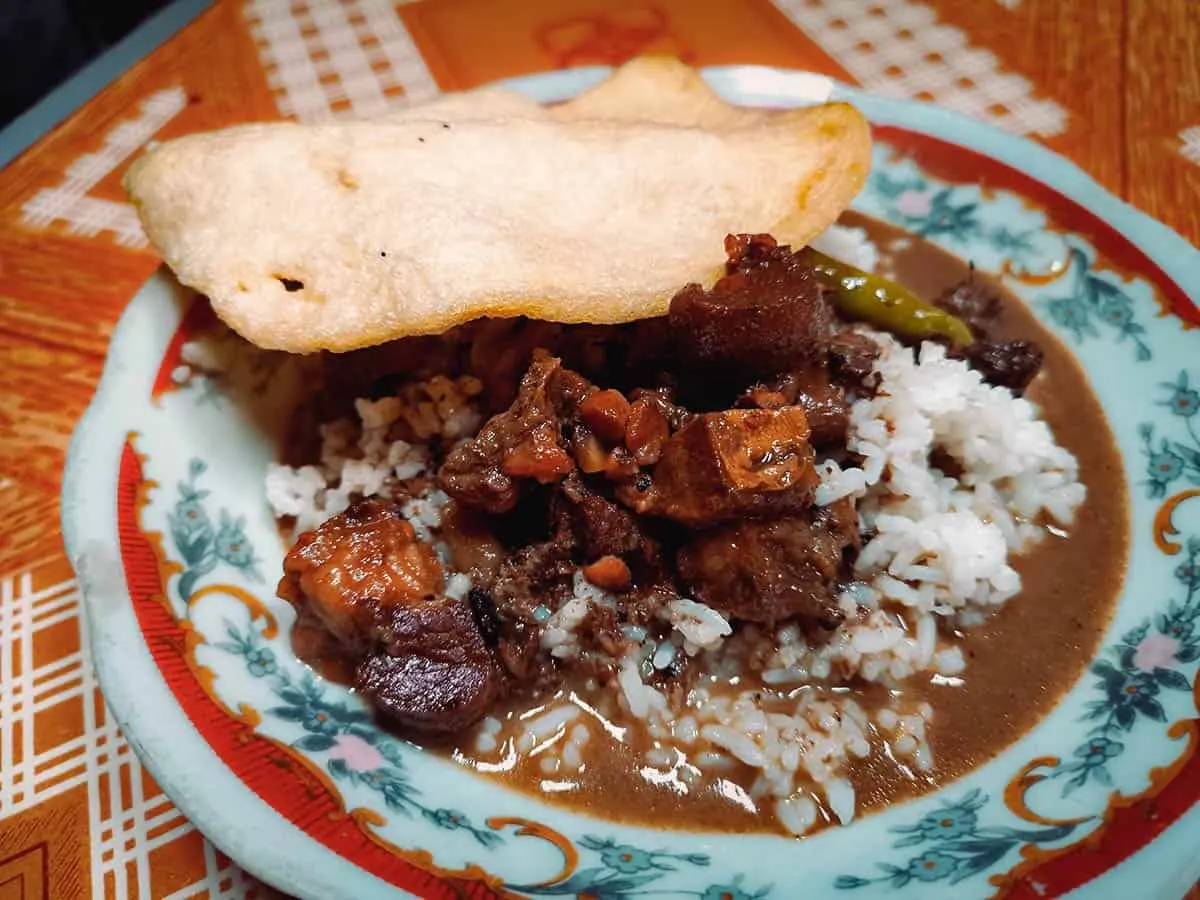
22. Gudeg
Gudeg, like nasi brongkos, is considered one of the most important Javanese dishes. It’s such an important dish that it was pretty much all I had on our most recent trip to Yogyakarta.
Gudeg consists of young unripe jackfruit that’s stewed for many hours with palm sugar, coconut milk, and a host of spices like garlic, shallots, galangal, coriander seed, candlenut, and teak leaves. It’s available in wet or dry versions and is typically served with steamed white rice, chicken, hard-boiled egg, tofu, tempeh, and a spicy stew made with crisp beef skin.
RECIPE: Gudeg Jogja
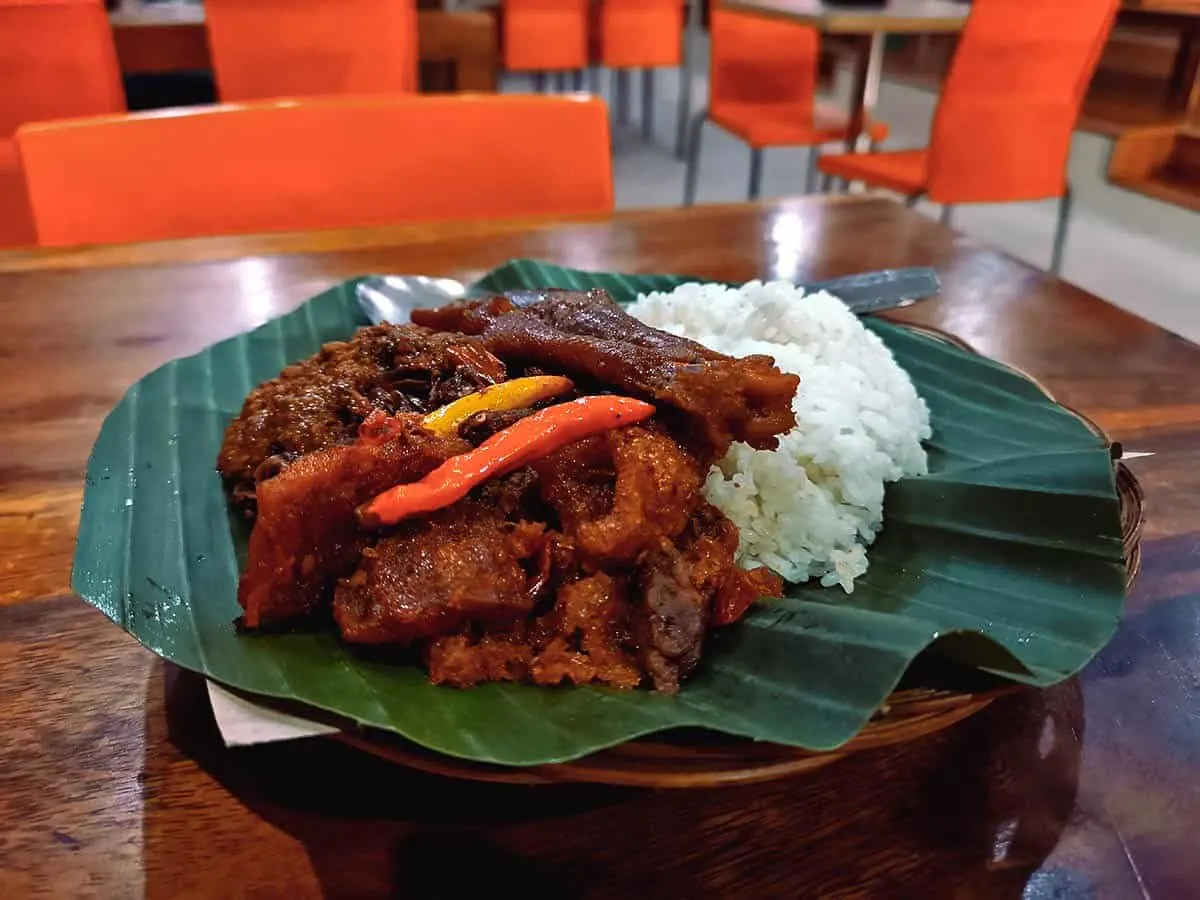
23. Babi Guling
Babi guling is one of the best and most delicious dishes you can have in Bali. It refers to a roasted pork dish made with suckling pig stuffed with a spice mixture called basa gede.
Babi guling refers specifically to roast suckling pig but it’s always served with steamed white rice, sambal, and a few side dishes like vegetables, pork satay, blood sausage, and a crispy shard of pork skin. I guess you can say that it’s a specific type of nasi campur?
In any case, the babi guling below was from Ibu Oka in Ubud, the warung made famous by Anthony Bourdain and No Reservations. It’s pretty good though definitely not the best babi guling in Bali.
RECIPE: Babi guling
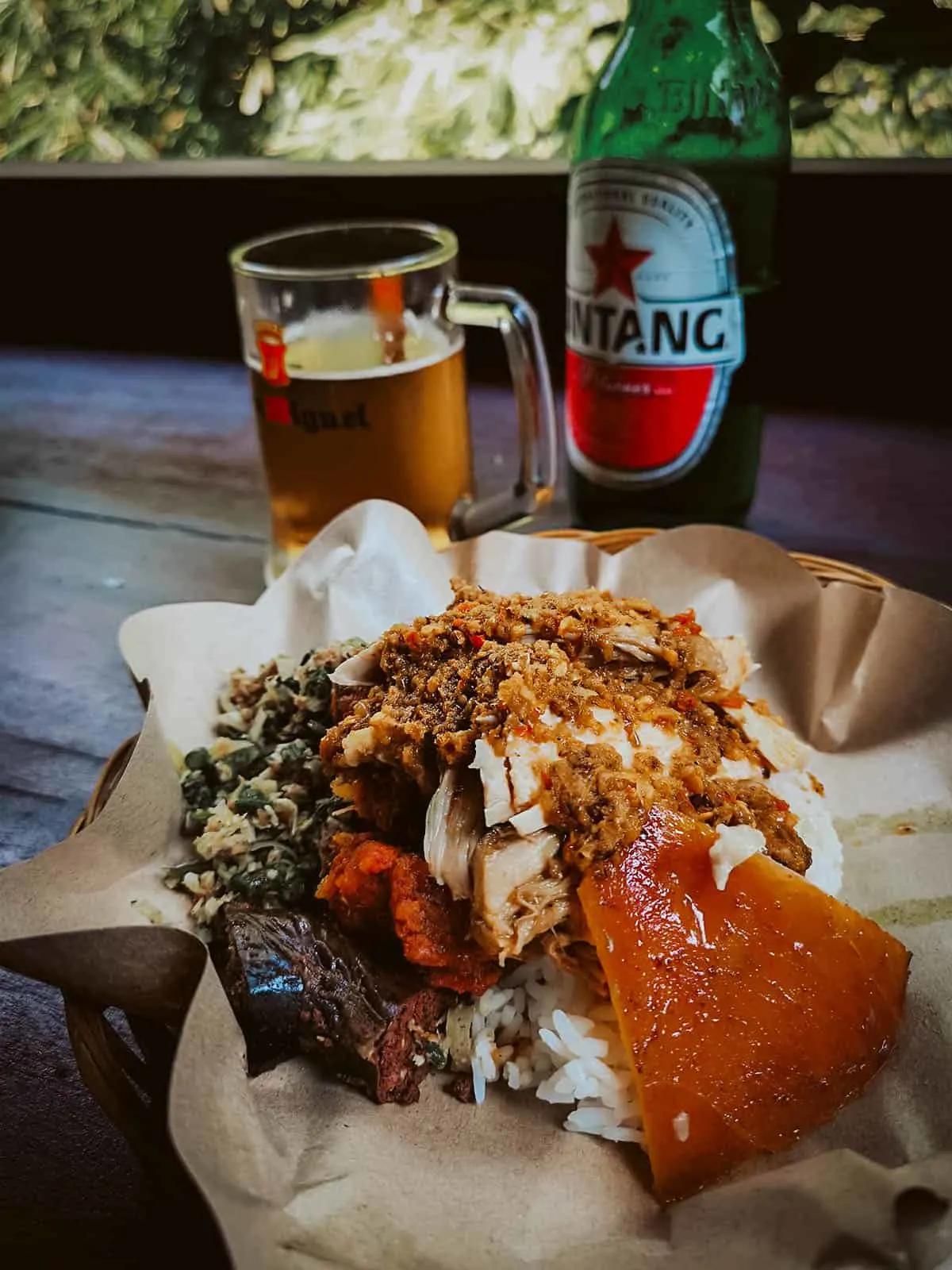
24. Mie Goreng
Mie goreng refers to a spicy type of Indonesian fried noodles. It’s one of the most popular dishes on this list, made even more famous by the hugely successful instant noodle brand Indomie.
Mie goreng is made with thin yellow noodles stir-fried with garlic, onion, chili, cabbage, tomato, egg, and other vegetables. It’s typically made with some type of meat like prawn, chicken, beef, or sliced bakso.
Like nasi goreng, mie goreng is an ubiquitous Indonesian dish that you can have pretty much anywhere in the country, from street food carts to warungs and high-end Indonesian restaurants. Thanks to Indomie, it’s something we can easily have even when we’re not in Indonesia.
RECIPE: Mie goreng
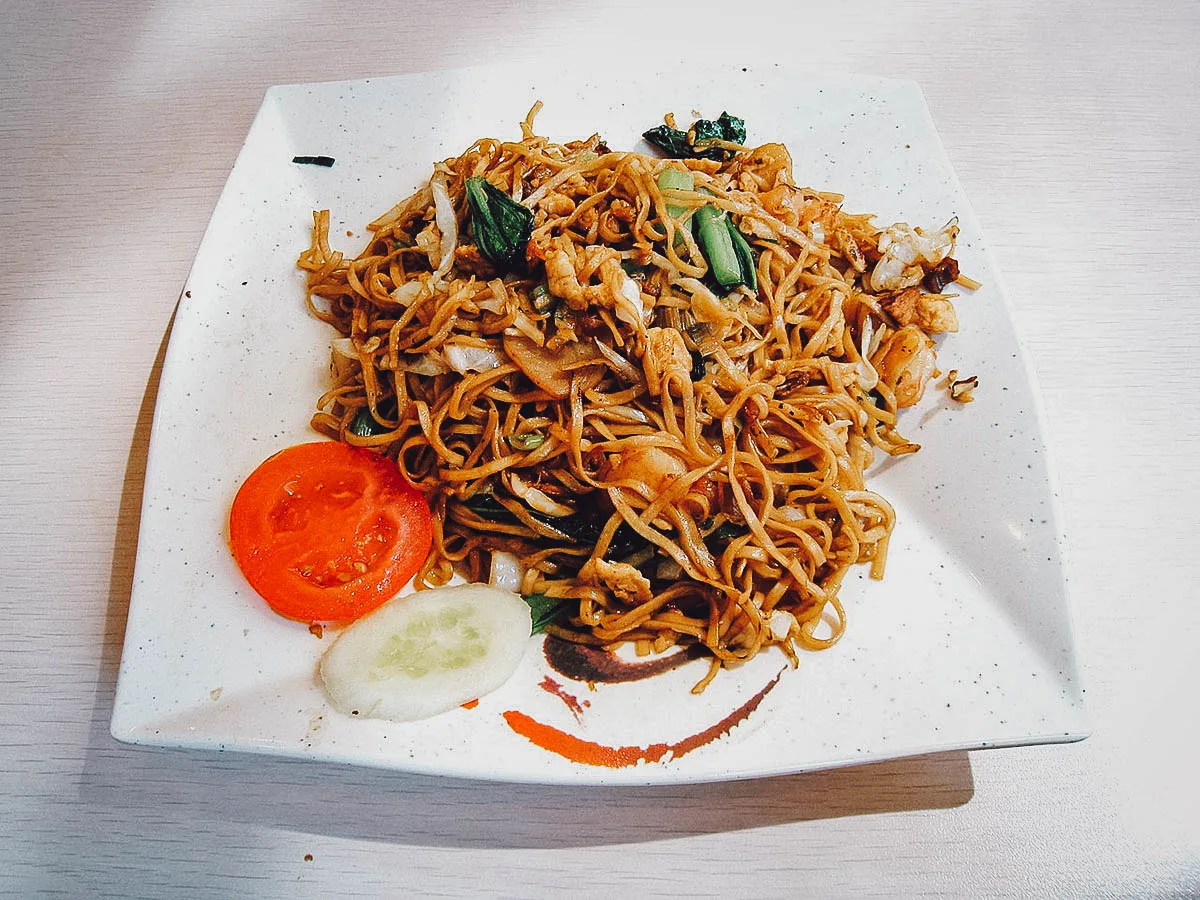
Gunawan Kartapranata, CC BY-SA 3.0, via Wikimedia Commons / Processed in Photoshop and Lightroom
CONDIMENTS
25. Sambal
As you may have noticed, I’ve mentioned sambal numerous times in this article. It’s a critical part of many Indonesian meals and deserves its own spot in this Indonesian food guide.
Sambal refers to an Indonesian chili sauce or paste made from a variety of chili peppers and any number of secondary ingredients like shrimp paste, garlic, shallots, scallions, ginger, palm sugar, and lime juice. You’ll find it served with many Indonesian dishes like ayam goreng, ikan bakar, nasi campur, babi guling, and more.
Like a few of the dishes on this list, sambal exists in many forms. There are an estimated 200-300 variations of sambal in Indonesia, most of them originating from Java. Depending on where it’s from, sambal can vary in heat level from being intensely hot to mildly spicy to spicy and sweet.
RECIPE: Sambal balado
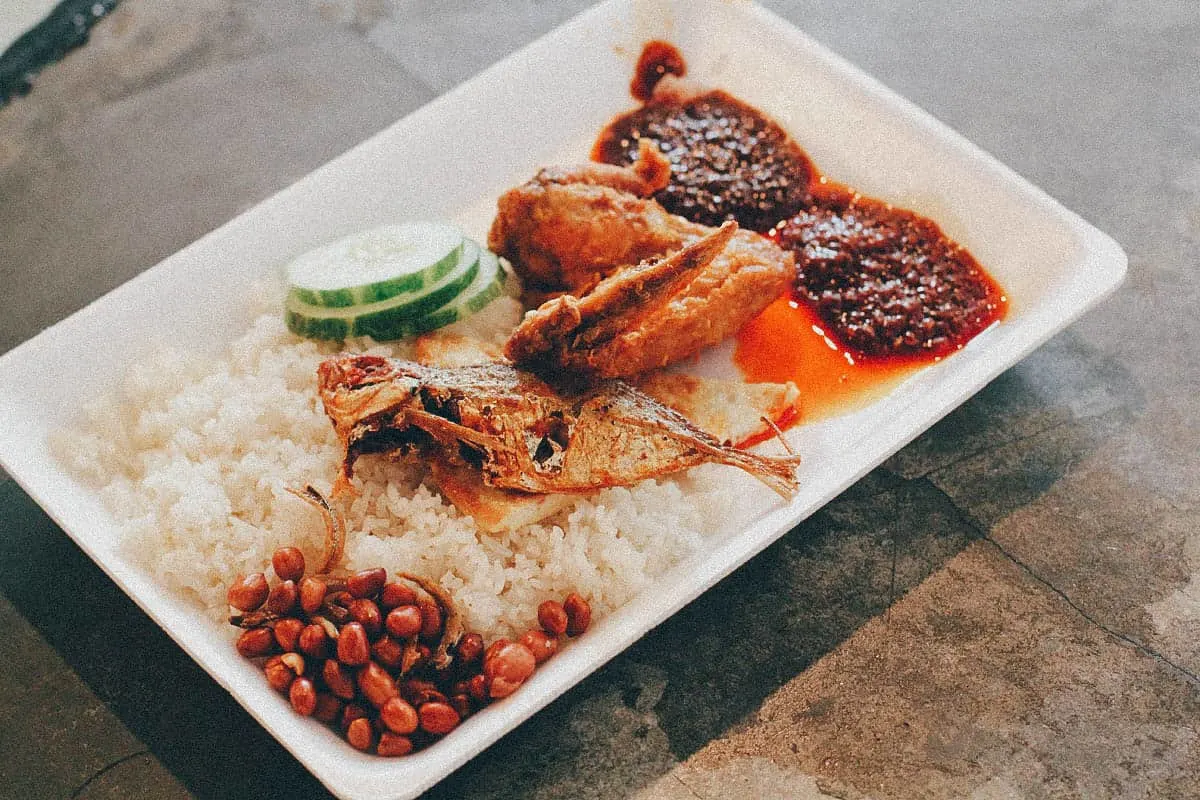
26. Kecap Manis
Kecap manis is another condiment I’ve mentioned quite often in this Indonesian food guide. It refers to a sweetened aromatic soy sauce often used in Indonesian cuisine, either as a cooking ingredient or as a dipping sauce.
Unlike regular soy sauce, kecap manis has a darker color and is thicker in consistency thanks to the addition of palm sugar. It tastes similar to molasses and is a frequently used ingredient in many Indonesian food favorites like sate, nasi goreng, bebek bakar, and other grilled dishes.
RECIPE: Homemade kecap manis
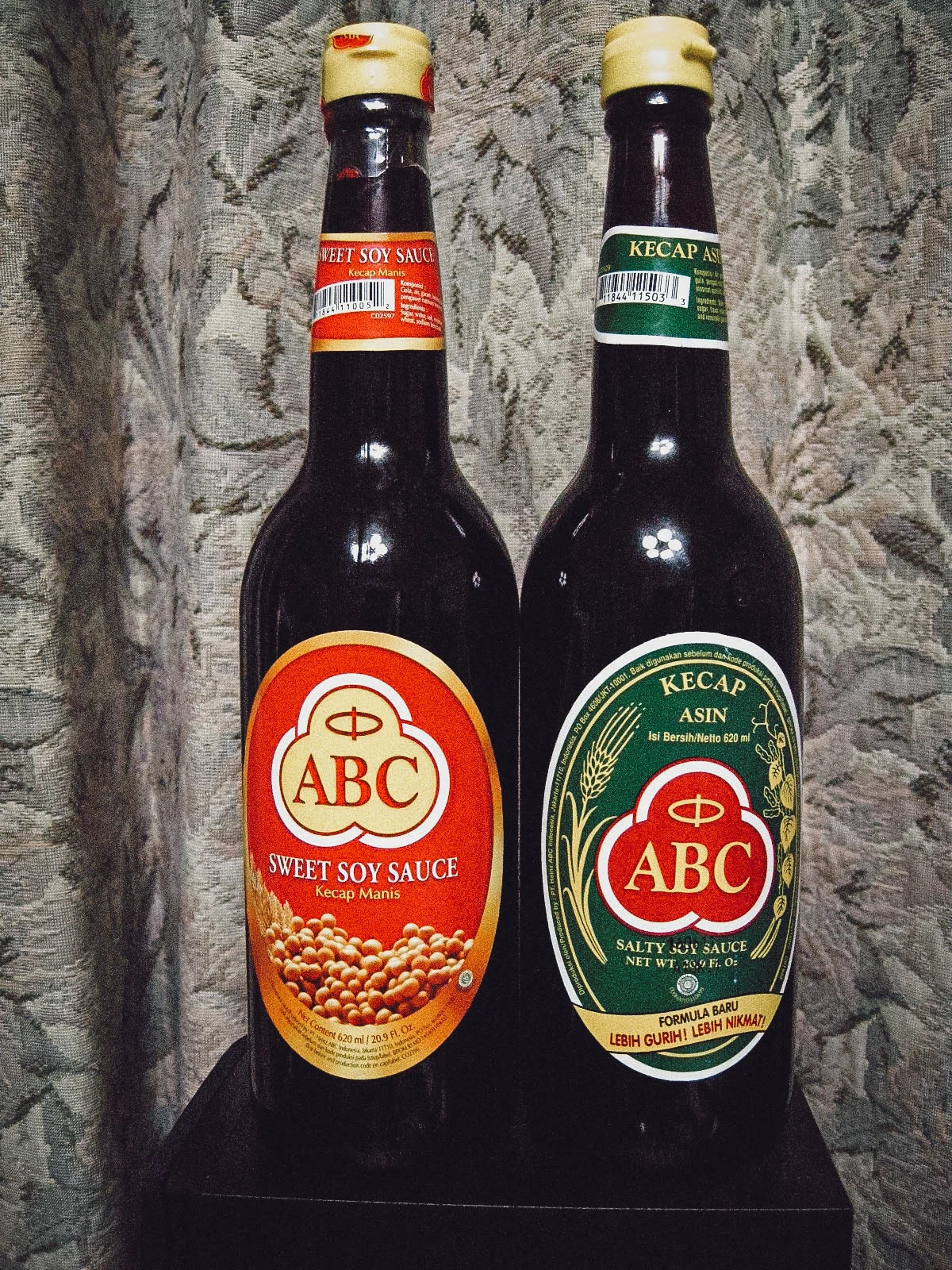
Jdmtdktdht, CC BY-SA 3.0, via Wikimedia Commons / Processed in Photoshop and Lightroom
DESSERTS
27. Ronde
Ronde or wedang ronde refers to a traditional Javanese dessert of glutinous rice balls (ronde) served in a hot ginger syrup (wedang). Indonesians like to refer to it as a drink which they often consume to warm up during the cooler winter months.
The rice balls are made in a variety of colors and come in different sizes, with the larger ones containing a filling made with ground peanuts and sugar. The syrup is made with loads of ginger so it tastes sweet, hot, and spicy. If you aren’t used to ginger, then you might find the taste to be a bit strong at first.
We enjoyed this bowl of ronde in the cooler climate of Bandung and it really does a good job of warming you up. You’ll feel a hot zingy sensation inside your throat as you drink the ginger syrup.
RECIPE: Wedang ronde
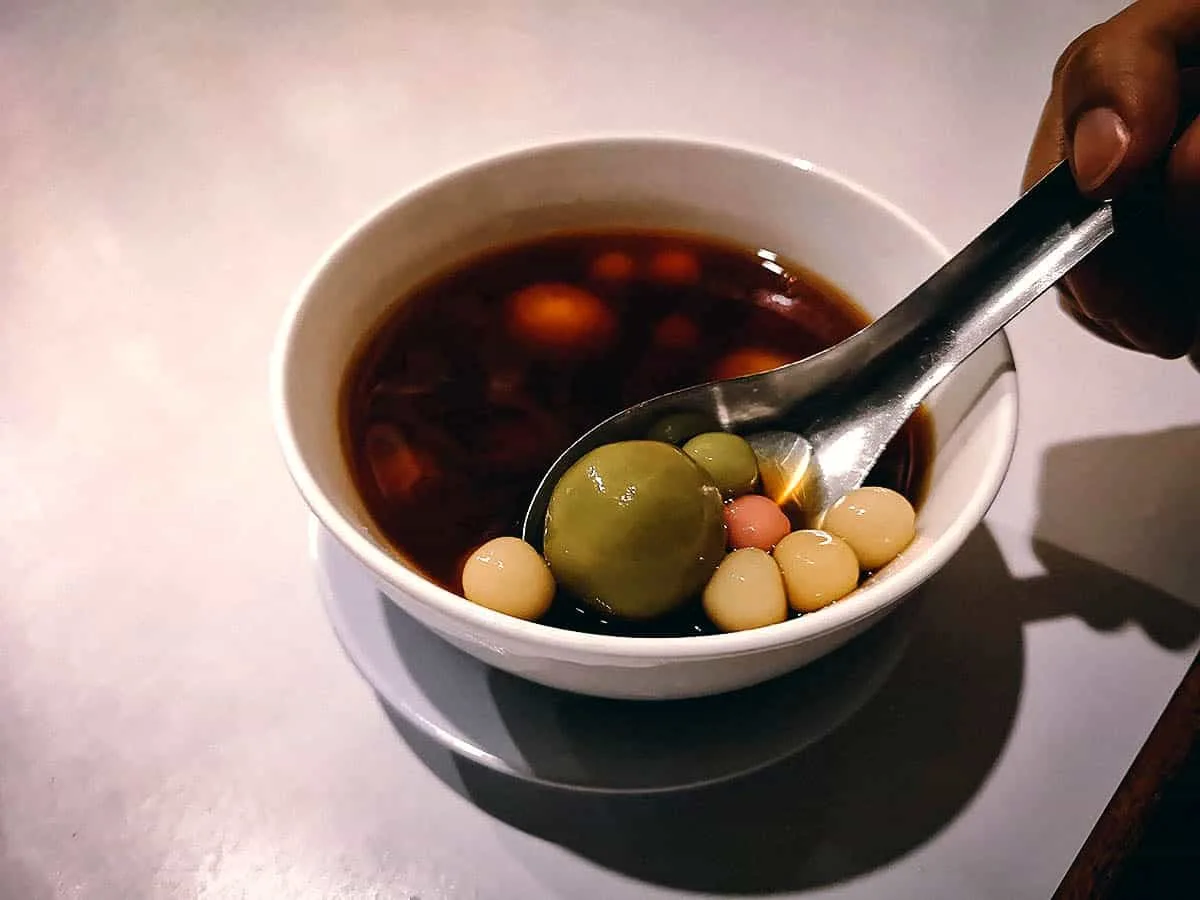
28. Martabak
Martabak refers to a family of stuffed pancakes or pan-fried breads commonly found in the Arabian Peninsula and in some parts of Southeast Asia. It’s believed to have originated from Yemen and has become a popular street food dish in Indonesia, Malaysia, and Singapore.
Martabak can be made in sweet or savory versions that look quite different from each other. Savory martabak look like large stuffed crepes while sweet versions (martabak manis) resemble thick pancakes topped with a variety of ingredients.
Visit any martabak stall and you’ll find them made with a limitless variety of ingredients. Common savory ingredients include egg, ground meat, green onions, herbs, and potatoes, while martabak manis can be topped with anything sweet like chocolate, Nutella, taro, bananas, candy sprinkles, and peanut butter.
RECIPE: Martabak manis
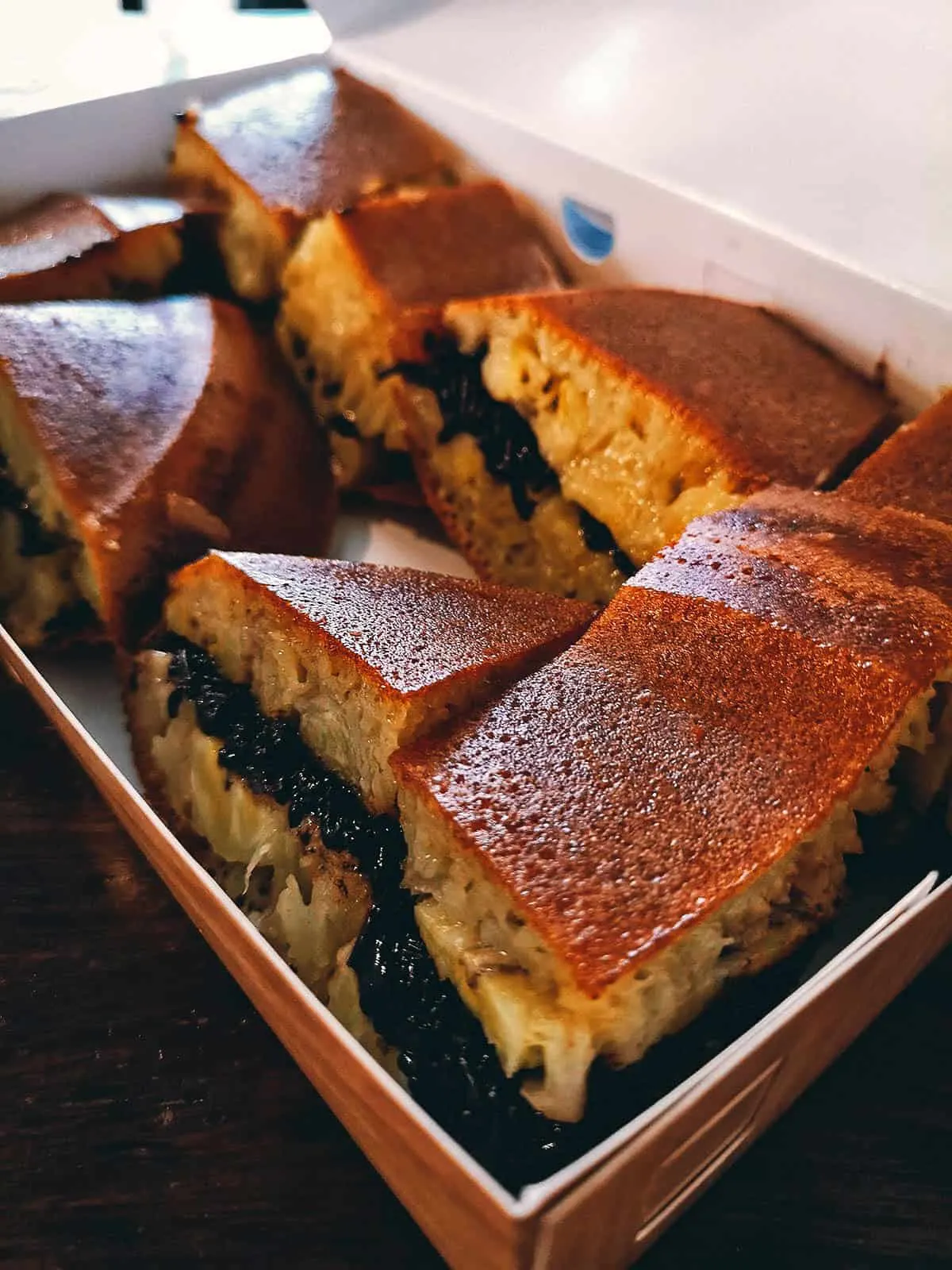
29. Surabi
Surabi or serabi refers to a type of Indonesian pancake made from rice flour cooked in a clay pot over charcoal. It’s similar to Thai khanom krok and is believed to have originated from Java.
Like martabak, surabi is made in sweet or savory versions. Sweet versions are traditionally served with a sauce made from coconut milk and palm sugar, but these days, they can be topped with any number of ingredients like banana, jackfruit, chocolate syrup, strawberries, and durian.
Aside from oncom, we haven’t tried savory surabi but I read that they can be made with ingredients like corned beef, cheese, shredded chicken, and sausage.
RECIPE: Kue serabi
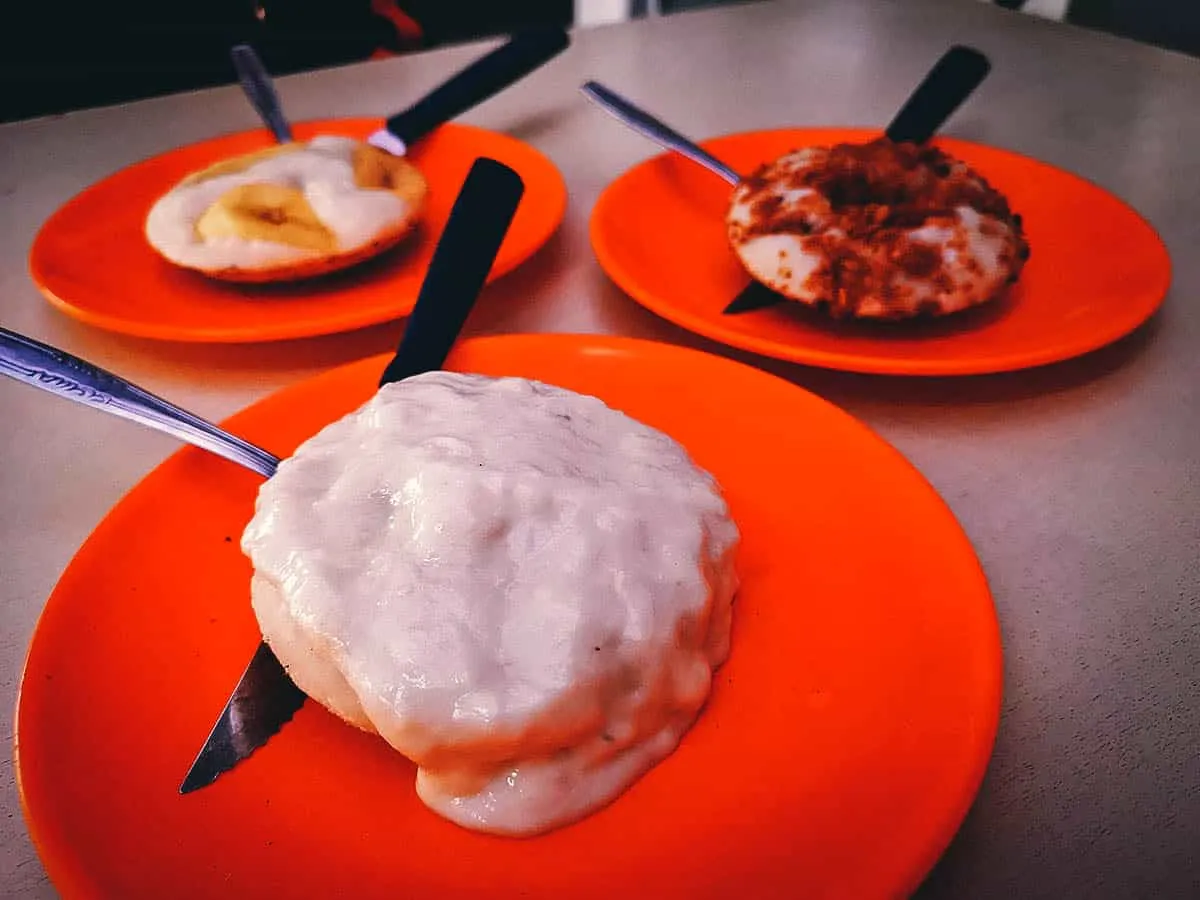
30. Kelepon
Kelepon refers to traditional Javanese rice cakes filled with liquid palm sugar and coated with fresh grated coconut. They’re bright green in color and considered a type of kueh, which is a family of bite-sized snacks or desserts popular in Indonesia, Malaysia, Singapore, and Brunei.
Kelepon dough is made with glutinous rice flour mixed with tapioca. It gets its green color from a paste made from pandan leaves.
To make, small pieces of solid palm sugar are inserted into the glutinous rice dough before they’re formed into balls and boiled. This turns the palm sugar into a liquid which bursts into your mouth when you take a bite of the kelepon. It’s so good.
RECIPE: Kelepon
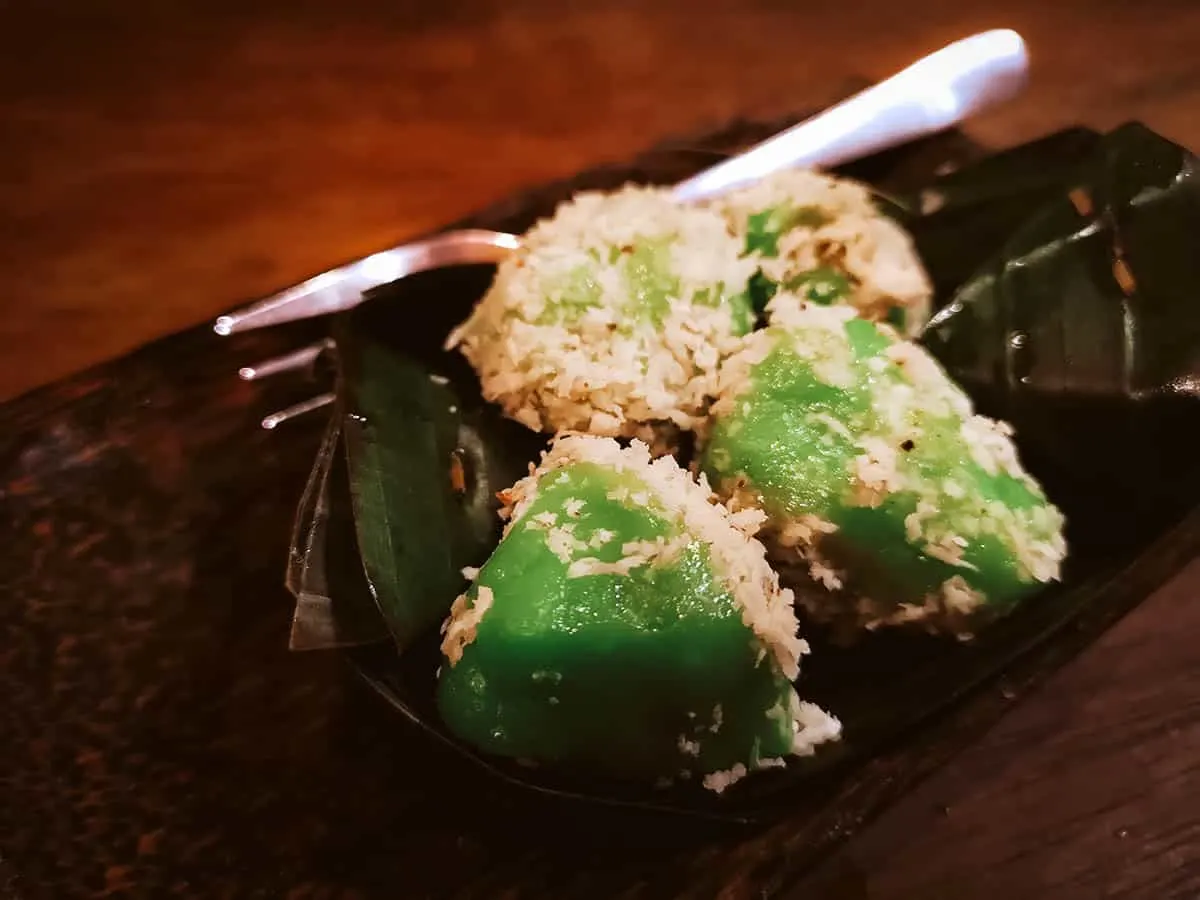
INDONESIAN FOOD TOURS
When it comes to Indonesian food, no one knows better than a local. What better way to experience Indonesian cuisine than by going on a food tour? A knowledgeable local will take you to the city’s best spots to try some of the tastiest examples of the local food. If you’re visiting Indonesia, then check out Get Your Guide for a list of food tours in different destinations throughout the archipelago.
INDONESIAN COOKING CLASSES
Aside from food tours, we love taking cooking classes on trips. On our most recent trip, we took a cooking class in Bali and learned to make Indonesian dishes like sate, gado-gado, and kare ayam. It was loads of fun and for me, one of the best ways to learn about the local cuisine. If you’re visiting Indonesia, then check out Cookly for a list of cooking classes in different cities throughout the country.
FINAL THOUGHTS ON INDONESIAN FOOD
As described at the top of this article, Indonesian food is incredibly diverse. The world’s largest archipelago has around 6,000 inhabited islands and almost as many traditional recipes so this list of 30 barely scratches the surface.
As with all our food guides, it’s something we plan on expanding and improving upon after every return trip to Indonesia. The islands of Sumatra and Sulawesi are of particular interest.
But if you’re interested mainly in traditional Indonesian food, then this list should be a good start. It includes some of the best dishes in Java, which based on what I’ve read, is still mostly indigenous. I’m not an expert but to me, that sounds like Javanese food represents some of the purest forms of Indonesian cuisine in the country.
In any case, I hope you enjoyed reading this guide and it helps lead you to some of the best food in Indonesia. Have a great trip!
Disclosure
Some of the links in this Indonesian food guide are affiliate links. We’ll get a small commission if you make a purchase at no additional cost to you. We only recommend products and services that we use ourselves and firmly believe in. We really appreciate your support as it helps us make more of these free travel guides. Thank you!


